

What’s the Value of a Museum Field Trip?
Critical thinking, connection to the past, and self-discovery are just three of the (proven) benefits of a class visit to the museum.
Erin Branham | July 16, 2015 | 3 min read
We all hear the news—the U.S. is behind in education. Our kids are having trouble mastering reading, math, and science. Schools lack teachers’ aides, computers, reliable internet, sometimes even basic classroom supplies. Can kids really afford to take a whole day, or even half a day, out of school to visit a museum? What’s the point?
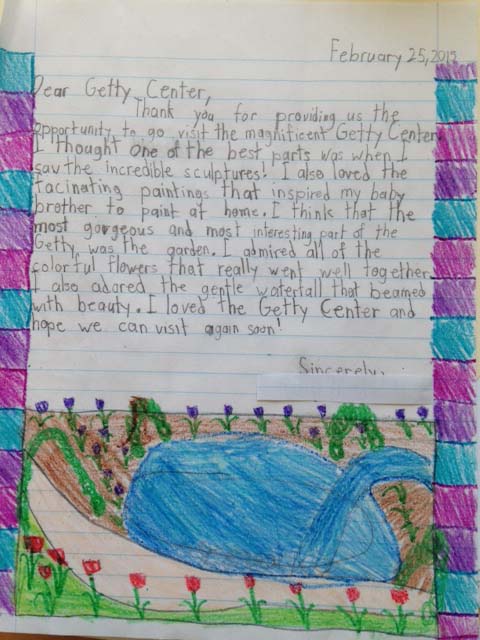
Many people feel instinctively that there is value to a museum field trip, but struggle to articulate exactly what it is. It’s good for kids to get out of the classroom a couple of times a year. It’s good for them to see knowledge at work in the real world. It’s good for them to experience subjects like the arts that are frequently absent from the classroom.
As the school programs manager at the Getty Museum, I know museum field trips have value, and it’s more than any of these things. The mission of the Getty’s school programs is to ignite interest in and foster discoveries about works of art by K-12 students. We facilitate experiences in which students learn how to explore their own perceptions and the possible meanings of works of art. They learn to make connections to other artworks, but also to their own lives, knowledge, and feelings, and to society both past and present. These are all aspects of learning that students themselves have identified as important.
Evidence from a recent study shows that even a single field trip can increase students’ ability to think critically about art, as well as their ability to appreciate and understand what life was like for people from other time periods. Each work of art is a window onto new worlds for students. Those worlds offer students a broadening of their own worlds.
During the 2014–15 school year, we welcomed over 160,000 K–12 students to the Getty Center and the Getty Villa. Of those, 73% came from Title I schools , and over 80% of those came to the Museum on buses paid for by the Getty. When we surveyed teachers, we learned that the cost of transportation is the number-one barrier to taking field trips. So today, any Title I school that is within a 30-mile radius of the Museum and can fill a bus with 50 students can get a free bus for their field trip.
The Museum is also committed to providing as many students as possible with a guided lesson in the galleries. This school year, our amazing, dedicated corps of 150 school-group docents provided over 100,000 students with guided tours.
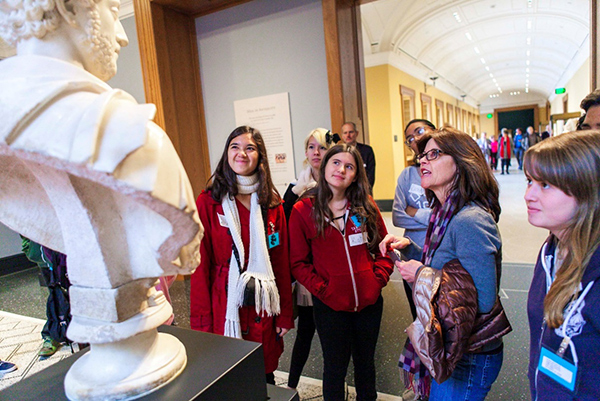
High school students in conversation with docent Barbara Atherton as they examine the Bust of Commodus.
A guided lesson lasts one hour and consists of stops in four galleries. From time to time we receive comments from teachers who urge us to make kids see as much of the Museum as possible, but we value time spent with single works of art–time that allows students to look, contemplate, and form opinions and perceptions about art.
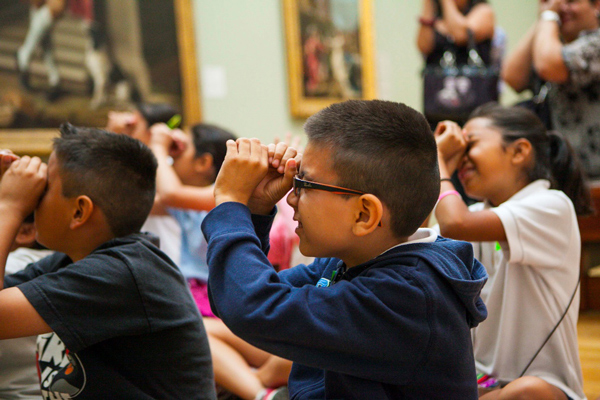
About a third of the Getty’s school visitors come on self-guided visits, which means that their teachers (not Getty docents) guide their visit. While we offer teachers many ideas and activities to use in our galleries, just as often teachers apply their own talents and devise their own creative lessons.
When we survey students, they almost always ask for more time to explore on their own, so we encourage even teachers who have booked guided lessons to allow time for students to do some unstructured exploration of the galleries.
For yet another great benefit of a museum field trip is simply letting students discover that free-choice learning environments like museums exist in their communities – places they can use for the rest of their lives to learn, to play, and to reflect. Places they can make their own. Every student who visits the Getty receives a free parking pass so that they can return with their families in the next few months, and each year thousands of people take advantage of a return visit.

Field trips have enormous benefit to museums as well. Museums are nonprofit organizations, and their public value has been the subject of essays, blogs , conferences , and books . Providing students with experiences connecting them to their cultural heritage, to beauty, and to thought-provoking works of art is one clear way museums provide value to society. Not only will many of these kids become the visitors and patrons of the future, but among them are also the future curators, conservators, educators, and, of course, artists, who will fill and operate museums for the next generation.
And not least for those of us who work in museums, the chance to meet and interact with the thoughtful, curious students flooding our galleries is one of the most exciting and joyful parts of our work.

- arts education
- J. Paul Getty Museum
- K-12 programs
About The Author
Erin branham.
I'm the education specialist for family programs at the Getty Villa. In addition to the Villa Teen Apprentice program, I oversee tours, workshops, and drop-in programs designed for parents and children to enjoy together as they learn about art of the ancient world. I've been in museum education for over 20 years and hold a master's degree in art education from the School of the Art Institute of Chicago.
Comments on this post are now closed.
I am happy for those kids who get to see the Getty – even if it is four items at a time. I was taken to museums as a child and for the most part hated it. As an adult I took my kids to museums and they loved it!!!! I was able to figure out as a child our visits were too long…. and my blood sugar plummeted and I would feel awful. Why did my kids love them….. they loved learning…. of all kinds and had each other to “discuss” what they were looking at. To master reading, math, and science there needs to be a love a learning… too bad we can’t pass a law and tax people for a love of learning. Keep up the work and if you can figure out a way to get more parents in your buildings – Go for It! The parking pass is a great start. I would love to see the Getty but am thousands of miles away. Will keep reading the blog!
I would like to bring a group of 70 students on a field trip to the museum. I would like to know the cost and is the date Tuesday May 30, 2017 a good day.
More Stories on the Iris
Dumbledore’s phoenix and the medieval bestiary, be a part of “fuzzy grids ii”, arts of luxury for the renaissance elite.
- Our Mission
Getting the Most Out of Museum Field Trips
A plan to give students agency over what they learn while visiting a museum creates a significantly more beneficial experience.
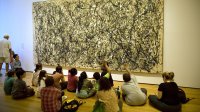
I’ve led many learners on several museum excursions, not just as a classroom teacher, but also as a museum educator and guide, and I’ve seen a lot of different takes on the field trip to a museum. Students can be divided up into tightly managed groups, or they can be let loose to explore. They can arrive equipped with worksheets, clipboards, and iPads, or just the questions in their heads.
In thinking about all the ways this learning experience can work, I’ve observed that the most pronounced differences in the value of this kind of experience came as a result of how a teacher answered three essential questions:
- What kind of structure will be provided for the visit?
- What will be done before and after the visit happens?
- How can the visit go beyond content acquisition?
Structuring For Success
Teachers have often asked me what level of independence is best for their visit. I’m not referring to freedom of movement or the level of supervision that students need. When I say independence, I’m talking about room to explore. Do you allow students complete freedom to move through the galleries and exhibits at will, or do you tightly schedule and curate their time to ensure that they get the topical information aligned to your learning goals?
In my experience, for a museum visit to be truly impactful, balance is needed, and the research seems to agree. Allowing learners a degree of choice in what they interact with in an informal learning space leads to deeper learning. However, we also know that students benefit from structure. Without it, they might end up seeing everything, learning nothing. You can use a scaffolded framework to get the best of both worlds, regardless of how long your visit might be.
First, begin your visit with the entire group together. This allows you to set the tone and model behavior for the visit, and you can take advantage of any educational programs the museum offers as a shared experience for your students. It also allows the staff to orient your students to resources that are relevant to your learning goals.
Then, divide your students into groups. Direct them to a specific exhibit or gallery that pertains to the learning goal that prompted your visit. As students move between the different displays or resources, you can circulate and provide guidance on things they should make sure to see, also noting which students are able to conduct themselves appropriately with less direct oversight.
Finally, allow them free choice. Students can explore other areas for the remainder of their trip in small groups. They can pursue unrelated but engaging topics that they might be interested in, even if they don’t directly relate to the purpose of your trip.
Teachers who have used this model to structure their visit reported higher participation and richer understanding from their students as a result.
Focus on the Before and After as Much as During
Permission slips, chaperones, worksheets. Teachers’ main focus when it comes to field trips is usually the logistics involved in getting there. Helping students think about the experience within the context of the unit or project they’re working on comes second, but there’s a simple way to bring it back to the forefront—anchor questions.
Creating an open-ended anchor question that guides the museum experience by tying the learning goal to the place is useful not only during the visit, but also before and after the experience. If you introduce the question to students early, they can focus on what they need to learn prior to their visit, and afterward they can use it to measure the success of their visit and consider next steps.
Here are some key questions that students can consider:
- What background information do you need in order to answer the question?
- What information or questions are you hoping to gain insight into during the visit?
- What sections or exhibits will be most helpful to explore when we arrive?
- What tools and resources can you gather ahead of time that will help you with finding answers?
- What resources or exhibits from the museum contributed to answering the anchor question?
- Did the visit leave any questions unanswered or generate new questions?
- Are there any new topics, even unrelated ones, that inspired curiosity?
Use Museums For More Than Content
Utilizing museums as a source of content information is fine, but textbooks do the same thing. So, if that’s your only plan for a museum visit, you’re missing opportunities to engage students in critical analysis. Many museums were built decades ago, and updating their exhibits to make them more relevant sometimes takes decades more. Without careful consideration, you might be unintentionally exposing students to developmentally inappropriate exhibits, outdated narratives, or less inclusive, and therefore inaccurate, information.
However, you can use the experience to create ownership and empower students to find ways to make these spaces more inclusive. When you do this, students not only consume information but are actively engaged in a revision process that asks them to think critically and play a role in the improvement of the experience for other visitors. Try the following three activities.
An option for young students. Art museums are great resources, but they are generally not designed for younger learners. Elementary students can engage with art and develop literacy at the same time when you give them adjectives and ask them to find a piece of art that fits their word. They can then write the name of or present their artwork and share why they think it’s a good fit for their assigned words. I’ve seen this done masterfully with Apples to Apples: Green Cards .
Stories told, stories hidden. Sometimes, what a museum doesn’t display can be even more informative than what it does display. Challenging students to look critically at the displays and consider what information is shared and what information might be missing can lead to interesting discussions about access and relevance. A great resource for this kind of exploration is the Field Trip guide from Monument Lab .
Remix the resources. Much of curators’ work in a museum involves the sequencing of objects so that they tell a story. Exploring “how objects speak” is a compelling concept that can lend itself to deeper learning after a visit. During a visit, students can look at objects from a particular gallery, take photos, and then create their own exhibits that incorporate the objects in service of new narratives. They can fill out their new exhibits with images or objects from resources like Google Arts & Culture .

- The Journal
- Vol. 14, No. 1
The Educational Value of Field Trips
Jay P. Greene
Brian Kisida
Daniel H. Bowen
Jay P. Greene joined EdNext Editor-in-chief Marty West to discuss the benefits of field trips, including how seeing live theater is a more enriching experience to students, on the EdNext podcast .

Crystal Bridges; Crystal Bridges Museum of American Art; School Tour © 2013 Stephen Ironside/Ironside Photography Bo Bartlett – “The Box” – 2002 • Oil on Linen • 82 x 100 – Photographer is Karen Mauch
The school field trip has a long history in American public education. For decades, students have piled into yellow buses to visit a variety of cultural institutions, including art, natural history, and science museums, as well as theaters, zoos, and historical sites. Schools gladly endured the expense and disruption of providing field trips because they saw these experiences as central to their educational mission: schools exist not only to provide economically useful skills in numeracy and literacy, but also to produce civilized young men and women who would appreciate the arts and culture. More-advantaged families may take their children to these cultural institutions outside of school hours, but less-advantaged students are less likely to have these experiences if schools do not provide them. With field trips, public schools viewed themselves as the great equalizer in terms of access to our cultural heritage.
Today, culturally enriching field trips are in decline. Museums across the country report a steep drop in school tours. For example, the Field Museum in Chicago at one time welcomed more than 300,000 students every year. Recently the number is below 200,000. Between 2002 and 2007, Cincinnati arts organizations saw a 30 percent decrease in student attendance. A survey by the American Association of School Administrators found that more than half of schools eliminated planned field trips in 2010–11.
The decision to reduce culturally enriching field trips reflects a variety of factors. Financial pressures force schools to make difficult decisions about how to allocate scarce resources, and field trips are increasingly seen as an unnecessary frill. Greater focus on raising student performance on math and reading standardized tests may also lead schools to cut field trips. Some schools believe that student time would be better spent in the classroom preparing for the exams. When schools do organize field trips, they are increasingly choosing to take students on trips to reward them for working hard to improve their test scores rather than to provide cultural enrichment. Schools take students to amusement parks, sporting events, and movie theaters instead of to museums and historical sites. This shift from “enrichment” to “reward” field trips is reflected in a generational change among teachers about the purposes of these outings. In a 2012‒13 survey we conducted of nearly 500 Arkansas teachers, those who had been teaching for at least 15 years were significantly more likely to believe that the primary purpose of a field trip is to provide a learning opportunity, while more junior teachers were more likely to see the primary purpose as “enjoyment.”
If schools are de-emphasizing culturally enriching field trips, has anything been lost as a result? Surprisingly, we have relatively little rigorous evidence about how field trips affect students. The research presented here is the first large-scale randomized-control trial designed to measure what students learn from school tours of an art museum.
We find that students learn quite a lot. In particular, enriching field trips contribute to the development of students into civilized young men and women who possess more knowledge about art, have stronger critical-thinking skills, exhibit increased historical empathy, display higher levels of tolerance, and have a greater taste for consuming art and culture.
Design of the Study and School Tours
The 2011 opening of the Crystal Bridges Museum of American Art in Northwest Arkansas created the opportunity for this study. Crystal Bridges is the first major art museum to be built in the United States in the last four decades, with more than 50,000 square feet of gallery space and an endowment in excess of $800 million. Portions of the museum’s endowment are devoted to covering all of the expenses associated with school tours. Crystal Bridges reimburses schools for the cost of buses, provides free admission and lunch, and even pays for the cost of substitute teachers to cover for teachers who accompany students on the tour.
Because the tour is completely free to schools, and because Crystal Bridges was built in an area that never previously had an art museum, there was high demand for school tours. Not all school groups could be accommodated right away. So our research team worked with the staff at Crystal Bridges to assign spots for school tours by lottery. During the first two semesters of the school tour program, the museum received 525 applications from school groups representing 38,347 students in kindergarten through grade 12. We created matched pairs among the applicant groups based on similarity in grade level and other demographic factors. An ideal and common matched pair would be adjacent grades in the same school. We then randomly ordered the matched pairs to determine scheduling prioritization. Within each pair, we randomly assigned which applicant would be in the treatment group and receive a tour that semester and which would be in the control group and have its tour deferred.
We administered surveys to 10,912 students and 489 teachers at 123 different schools three weeks, on average, after the treatment group received its tour. The student surveys included multiple items assessing knowledge about art as well as measures of critical thinking, historical empathy, tolerance, and sustained interest in visiting art museums. Some groups were surveyed as late as eight weeks after the tour, but it was not possible to collect data after longer periods because each control group was guaranteed a tour during the following semester as a reward for its cooperation. There is no indication that the results reported below faded for groups surveyed after longer periods.
We also assessed students’ critical-thinking skills by asking them to write a short essay in response to a painting that they had not previously seen. Finally, we collected a behavioral measure of interest in art consumption by providing all students with a coded coupon good for free family admission to a special exhibit at the museum to see whether the field trip increased the likelihood of students making future visits.
All results reported below are derived from regression models that control for student grade level and gender and make comparisons within each matched pair, while taking into account the fact that students in the matched pair of applicant groups are likely to be similar in ways that we are unable to observe. Standard validity tests confirmed that the survey items employed to generate the various scales used as outcomes measured the same underlying constructs.
The intervention we studied is a modest one. Students received a one-hour tour of the museum in which they typically viewed and discussed five paintings. Some students were free to roam the museum following their formal tour, but the entire experience usually involved less than half a day. Instructional materials were sent to teachers who went on a tour, but our survey of teachers suggests that these materials received relatively little attention, on average no more than an hour of total class time. The discussion of each painting during the tour was largely student-directed, with the museum educators facilitating the discourse and providing commentary beyond the names of the work and the artist and a brief description only when students requested it. This format is now the norm in school tours of art museums. The aversion to having museum educators provide information about works of art is motivated in part by progressive education theories and by a conviction among many in museum education that students retain very little factual information from their tours.
Recalling Tour Details. Our research suggests that students actually retain a great deal of factual information from their tours. Students who received a tour of the museum were able to recall details about the paintings they had seen at very high rates. For example, 88 percent of the students who saw the Eastman Johnson painting At the Camp—Spinning Yarns and Whittling knew when surveyed weeks later that the painting depicts abolitionists making maple syrup to undermine the sugar industry, which relied on slave labor. Similarly, 82 percent of those who saw Norman Rockwell’s Rosie the Riveter could recall that the painting emphasizes the importance of women entering the workforce during World War II. Among students who saw Thomas Hart Benton’s Ploughing It Under , 79 percent recollected that it is a depiction of a farmer destroying his crops as part of a Depression-era price support program. And 70 percent of the students who saw Romare Bearden’s Sacrifice could remember that it is part of the Harlem Renaissance art movement. Since there was no guarantee that these facts would be raised in student-directed discussions, and because students had no particular reason for remembering these details (there was no test or grade associated with the tours), it is impressive that they could recall historical and sociological information at such high rates.
These results suggest that art could be an important tool for effectively conveying traditional academic content, but this analysis cannot prove it. The control-group performance was hardly better than chance in identifying factual information about these paintings, but they never had the opportunity to learn the material. The high rate of recall of factual information by students who toured the museum demonstrates that the tours made an impression. The students could remember important details about what they saw and discussed.
Critical Thinking. Beyond recalling the details of their tour, did a visit to an art museum have a significant effect on students? Our study demonstrates that it did. For example, students randomly assigned to receive a school tour of Crystal Bridges later displayed demonstrably stronger ability to think critically about art than the control group.
During the first semester of the study, we showed all 3rd- through 12th-grade students a painting they had not previously seen, Bo Bartlett’s The Box . We then asked students to write short essays in response to two questions: What do you think is going on in this painting? And, what do you see that makes you think that? These are standard prompts used by museum educators to spark discussion during school tours.
We stripped the essays of all identifying information and had two coders rate the compositions using a seven-item rubric for measuring critical thinking that was developed by researchers at the Isabella Stewart Gardner Museum in Boston. The measure is based on the number of instances that students engaged in the following in their essays: observing, interpreting, evaluating, associating, problem finding, comparing, and flexible thinking. Our measure of critical thinking is the sum of the counts of these seven items. In total, our research team blindly scored 3,811 essays. For 750 of those essays, two researchers scored them independently. The scores they assigned to the same essay were very similar, demonstrating that we were able to measure critical thinking about art with a high degree of inter-coder reliability.
We express the impact of a school tour of Crystal Bridges on critical-thinking skills in terms of standard-deviation effect sizes. Overall, we find that students assigned by lottery to a tour of the museum improve their ability to think critically about art by 9 percent of a standard deviation relative to the control group. The benefit for disadvantaged groups is considerably larger (see Figure 1). Rural students, who live in towns with fewer than 10,000 people, experience an increase in critical-thinking skills of nearly one-third of a standard deviation. Students from high-poverty schools (those where more than 50 percent of students receive free or reduced-price lunches) experience an 18 percent effect-size improvement in critical thinking about art, as do minority students.

A large amount of the gain in critical-thinking skills stems from an increase in the number of observations that students made in their essays. Students who went on a tour became more observant, noticing and describing more details in an image. Being observant and paying attention to detail is an important and highly useful skill that students learn when they study and discuss works of art. Additional research is required to determine if the gains in critical thinking when analyzing a work of art would transfer into improved critical thinking about other, non-art-related subjects.
Historical Empathy. Tours of art museums also affect students’ values. Visiting an art museum exposes students to a diversity of ideas, peoples, places, and time periods. That broadening experience imparts greater appreciation and understanding. We see the effects in significantly higher historical empathy and tolerance measures among students randomly assigned to a school tour of Crystal Bridges.
Historical empathy is the ability to understand and appreciate what life was like for people who lived in a different time and place. This is a central purpose of teaching history, as it provides students with a clearer perspective about their own time and place. To measure historical empathy, we included three statements on the survey with which students could express their level of agreement or disagreement: 1) I have a good understanding of how early Americans thought and felt; 2) I can imagine what life was like for people 100 years ago; and 3) When looking at a painting that shows people, I try to imagine what those people are thinking. We combined these items into a scale measuring historical empathy.
Students who went on a tour of Crystal Bridges experience a 6 percent of a standard deviation increase in historical empathy. Among rural students, the benefit is much larger, a 15 percent of a standard deviation gain. We can illustrate this benefit by focusing on one of the items in the historical empathy scale. When asked to agree or disagree with the statement, “I have a good understanding of how early Americans thought and felt,” 70 percent of the treatment-group students express agreement compared to 66 percent of the control group. Among rural participants, 69 percent of the treatment-group students agree with this statement compared to 62 percent of the control group. The fact that Crystal Bridges features art from different periods in American history may have helped produce these gains in historical empathy.
Tolerance. To measure tolerance we included four statements on the survey to which students could express their level of agreement or disagreement: 1) People who disagree with my point of view bother me; 2) Artists whose work is critical of America should not be allowed to have their work shown in art museums; 3) I appreciate hearing views different from my own; and 4) I think people can have different opinions about the same thing. We combined these items into a scale measuring the general effect of the tour on tolerance.
Overall, receiving a school tour of an art museum increases student tolerance by 7 percent of a standard deviation. As with critical thinking, the benefits are much larger for students in disadvantaged groups. Rural students who visited Crystal Bridges experience a 13 percent of a standard deviation improvement in tolerance. For students at high-poverty schools, the benefit is 9 percent of a standard deviation.
The improvement in tolerance for students who went on a tour of Crystal Bridges can be illustrated by the responses to one of the items within the tolerance scale. When asked about the statement, “Artists whose work is critical of America should not be allowed to have their work shown in art museums,” 35 percent of the control-group students express agreement. But for students randomly assigned to receive a school tour of the art museum, only 32 percent agree with censoring art critical of America. Among rural students, 34 percent of the control group would censor art compared to 30 percent for the treatment group. In high-poverty schools, 37 percent of the control-group students would censor compared to 32 percent of the treatment-group students. These differences are not huge, but neither is the intervention. These changes represent the realistic improvement in tolerance that results from a half-day experience at an art museum.
Interest in Art Museums. Perhaps the most important outcome of a school tour is whether it cultivates an interest among students in returning to cultural institutions in the future. If visiting a museum helps improve critical thinking, historical empathy, tolerance, and other outcomes not measured in this study, then those benefits would compound for students if they were more likely to frequent similar cultural institutions throughout their life. The direct effects of a single visit are necessarily modest and may not persist, but if school tours help students become regular museum visitors, they may enjoy a lifetime of enhanced critical thinking, tolerance, and historical empathy.
We measured how school tours of Crystal Bridges develop in students an interest in visiting art museums in two ways: with survey items and a behavioral measure. We included a series of items in the survey designed to gauge student interest:
• I plan to visit art museums when I am an adult.
• I would tell my friends they should visit an art museum.
• Trips to art museums are interesting.
• Trips to art museums are fun.
• Would your friend like to go to an art museum on a field trip?
• Would you like more museums in your community?
• How interested are you in visiting art museums?
• If your friends or family wanted to go to an art museum, how interested would you be in going?
Interest in visiting art museums among students who toured the museum is 8 percent of a standard deviation higher than that in the randomized control group. Among rural students, the increase is much larger: 22 percent of a standard deviation. Students at high-poverty schools score 11 percent of a standard deviation higher on the cultural consumer scale if they were randomly assigned to tour the museum. And minority students gain 10 percent of a standard deviation in their desire to be art consumers.
One of the eight items in the art consumer scale asked students to express the extent to which they agreed or disagreed with the statement, “I would tell my friends they should visit an art museum.” For all students who received a tour, 70 percent agree with this statement, compared to 66 percent in the control group. Among rural participants, 73 percent of the treatment-group students agree versus 63 percent of the control group. In high-poverty schools, 74 percent would recommend art museums to their friends compared to 68 percent of the control group. And among minority students, 72 percent of those who received a tour would tell their friends to visit an art museum, relative to 67 percent of the control group. Students, particularly those from disadvantaged backgrounds, are more likely to have positive feelings about visiting museums if they receive a school tour.
We also measured whether students are more likely to visit Crystal Bridges in the future if they received a school tour. All students who participated in the study during the first semester, including those who did not receive a tour, were provided with a coupon that gave them and their families free entry to a special exhibit at Crystal Bridges. The coupons were coded so that we could determine the applicant group to which students belonged. Students had as long as six months after receipt of the coupon to use it.
We collected all redeemed coupons and were able to calculate how many adults and youths were admitted. Though students in the treatment group received 49 percent of all coupons that were distributed, 58 percent of the people admitted to the special exhibit with those coupons came from the treatment group. In other words, the families of students who received a tour were 18 percent more likely to return to the museum than we would expect if their rate of coupon use was the same as their share of distributed coupons.
This is particularly impressive given that the treatment-group students had recently visited the museum. Their desire to visit a museum might have been satiated, while the control group might have been curious to visit Crystal Bridges for the first time. Despite having recently been to the museum, students who received a school tour came back at higher rates. Receiving a school tour cultivates a taste for visiting art museums, and perhaps for sharing the experience with others.
Disadvantaged Students
One consistent pattern in our results is that the benefits of a school tour are generally much larger for students from less-advantaged backgrounds. Students from rural areas and high-poverty schools, as well as minority students, typically show gains that are two to three times larger than those of the total sample. Disadvantaged students assigned by lottery to receive a school tour of an art museum make exceptionally large gains in critical thinking, historical empathy, tolerance, and becoming art consumers.
It appears that the less prior exposure to culturally enriching experiences students have, the larger the benefit of receiving a school tour of a museum. We have some direct measures to support this explanation. To isolate the effect of the first time visiting the museum, we truncated our sample to include only control-group students who had never visited Crystal Bridges and treatment-group students who had visited for the first time during their tour. The effect for this first visit is roughly twice as large as that for the overall sample, just as it is for disadvantaged students.
In addition, we administered a different version of our survey to students in kindergarten through 2nd grade. Very young students are less likely to have had previous exposure to culturally enriching experiences. Very young students make exceptionally large improvements in the observed outcomes, just like disadvantaged students and first-time visitors.
When we examine effects for subgroups of advantaged students, we typically find much smaller or null effects. Students from large towns and low-poverty schools experience few significant gains from their school tour of an art museum. If schools do not provide culturally enriching experiences for these students, their families are likely to have the inclination and ability to provide those experiences on their own. But the families of disadvantaged students are less likely to substitute their own efforts when schools do not offer culturally enriching experiences. Disadvantaged students need their schools to take them on enriching field trips if they are likely to have these experiences at all.
Policy Implications
School field trips to cultural institutions have notable benefits. Students randomly assigned to receive a school tour of an art museum experience improvements in their knowledge of and ability to think critically about art, display stronger historical empathy, develop higher tolerance, and are more likely to visit such cultural institutions as art museums in the future. If schools cut field trips or switch to “reward” trips that visit less-enriching destinations, then these important educational opportunities are lost. It is particularly important that schools serving disadvantaged students provide culturally enriching field trip experiences.
This first-ever, large-scale, random-assignment experiment of the effects of school tours of an art museum should help inform the thinking of school administrators, educators, policymakers, and philanthropists. Policymakers should consider these results when deciding whether schools have sufficient resources and appropriate policy guidance to take their students on tours of cultural institutions. School administrators should give thought to these results when deciding whether to use their resources and time for these tours. And philanthropists should weigh these results when deciding whether to build and maintain these cultural institutions with quality educational programs. We don’t just want our children to acquire work skills from their education; we also want them to develop into civilized people who appreciate the breadth of human accomplishments. The school field trip is an important tool for meeting this goal.
Jay P. Greene is professor of education reform at the University of Arkansas, where Brian Kisida is a senior research associate and Daniel H. Bowen is a doctoral student.
Additional materials, including a supplemental study and a methodological appendix , are available.
For more, please see “ The Top 20 Education Next Articles of 2023 .”
This article appeared in the Winter 2014 issue of Education Next . Suggested citation format:
Greene, J.P., Kisida, B., and Bowen, D.H. (2014). The Educational Value of Field Trips: Taking students to an art museum improves critical thinking skills, and more . Education Next , 14(1), 78-86.
Last Updated
License this Content
Latest Issue
Summer 2024.
Vol. 24, No. 3
We Recommend You Read
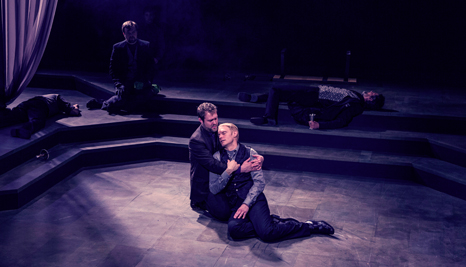
Learning from Live Theater
Students realize gains in knowledge, tolerance, and more
by Jay P. Greene
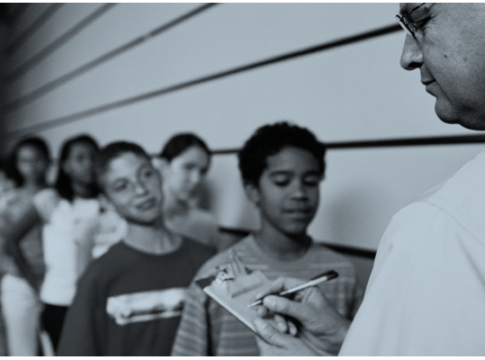
Getting Ahead by Staying Behind
An evaluation of Florida’s program to end social promotion
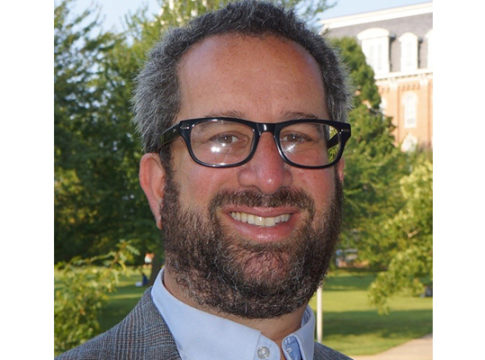
Straight Up Conversation: Scholar Jay Greene on the Importance of Field Trips
by Frederick Hess
- Venue Rentals
- Traveling Exhibitions
- Sue the T-Rex
- Field Trip Guides
Breadcrumbs
- Educators /
- Learning Resources /
Dive deeper into the Field’s exhibitions with activities that complement classroom learning.
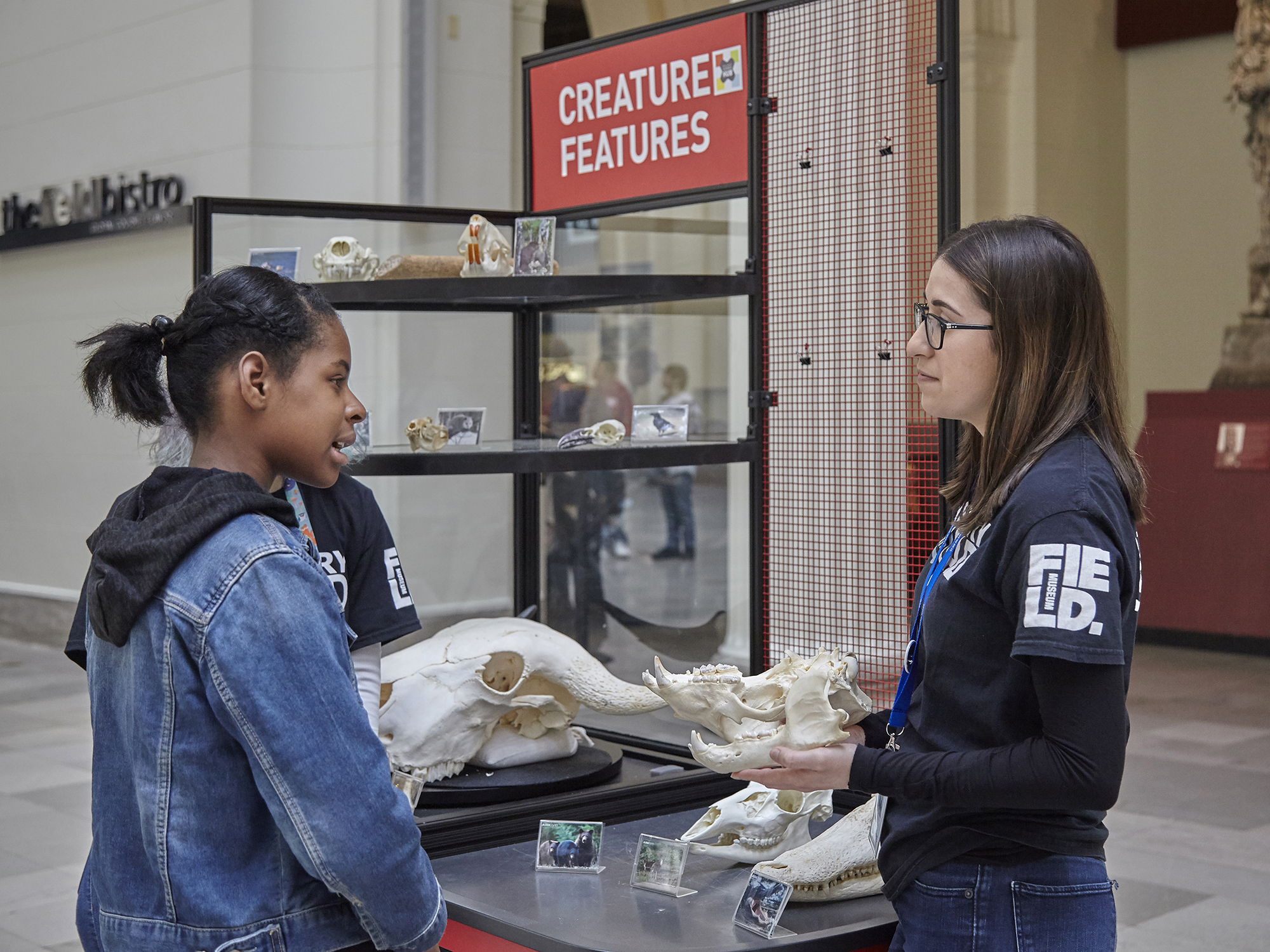
Plan a field trip that's full of discovery
Make the most of your day at the Field with resources designed for school groups pre-K through grade 12. Guide your students through an exhibition with engaging conversation starters and activities. Encourage their curiosity in cultures and the natural world as they examine specimens and artifacts on display.
Your guide to exploring the Field
Use these versatile in-museum activities to design a focused learning experience for your students.
Exhibition Investigation Guide
Investigate a museum exhibition using the claim, evidence, reasoning cycle.
- Download English PDF
Artifact Observation Guide
Encourage close examination of a single artifact—an object produced by humans—using observations and inferences.
Specimen Observation Guide
Encourage close examination of a single specimen—a collected example of a particular species or type—using observations and inferences.
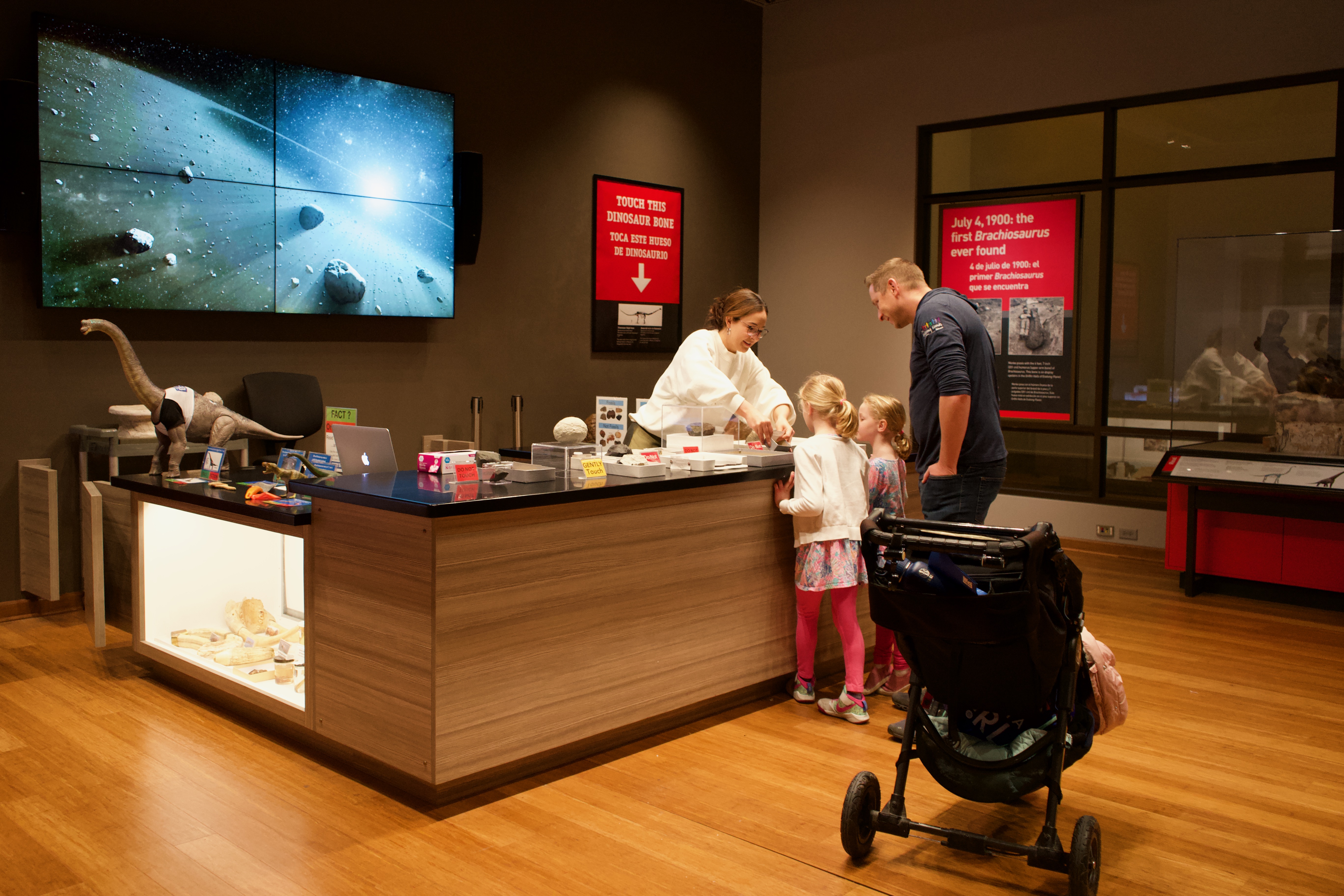
Field Trip Planning and In-Museum Resources
Filter controls, currently active filters.
Showing 19 resources
Ancient Americas Educator Guide
Investigate diverse cultures across different times and geographic locations in the Ancient Americas exhibition.
- Download Spanish PDF
Chicago Before Skyscrapers | Exploring the Field Guide
Observe a local ecosystem and infer how Native Americans of the Chicago region have traditionally used these resources.
Conservation in Action | Exploring the Field Guide
Examine different ways that scientists and community members conserve the environment, then analyze the results.
Diversity of Life | Exploring the Field Guide
Observe animal dioramas to compare and contrast organisms and explore the diversity of life.
Everything Has a Purpose | Exploring the Field Guide
Examine why plants and birds have certain features to uncover the relationship between structure and function.
Exploring Artifacts from the Pacific | Exploring the Field Guide
Observe and analyze artifacts from the Pacific Islands to develop evidence-based claims about how these cultures view the world.
Exploring Cultures | Exploring the Field Guide
Look closely at artifacts to learn how culture and geography create similarities and differences between China and Egypt.
Families Across Place and Time | Exploring the Field Guide
Explore similarities and differences between families across different geographic locations and time periods.
Grainger Hall of Gems Educator Guide
Explore the geological and cultural significance of a variety of gems.
Hominid Adaptations | Exploring the Field Guide
Investigate fossil remains of hominids to learn how humans and our relatives evolved over time.
Native Truths Teacher Reference Guide
Educators encourage critical thinking into current issues and modern cultures of today’s Native communities with these helpful resources.
Plants of the World Exhibition Guide
Observe intricate plant models to determine the functions of their unique structures.
Protecting Earth's Ecosystem | Exploring the Field Guide
Analyze methods used to address environmental issues and design strategies to protect local ecosystems.
Relationships in Ecosystems | Exploring the Field Guide
Investigate an ecosystem by observing the individual organisms as part of a larger structure—a food web.
Societies in the Ancient Americas | Exploring the Field Guide
Observe six types of societies that developed in the Americas in response to specific environmental conditions.
Survival of the Birds | Exploring the Field Guide
Infer whether a bird can survive in a specific environment by observing physical features such as beak, feathers, legs, and feet.
What Do Animals Eat? | Exploring the Field Guide
Investigate the relationship between an animal and its environment by identifying possible food sources in each habitat.
Recommended exhibitions for field trips
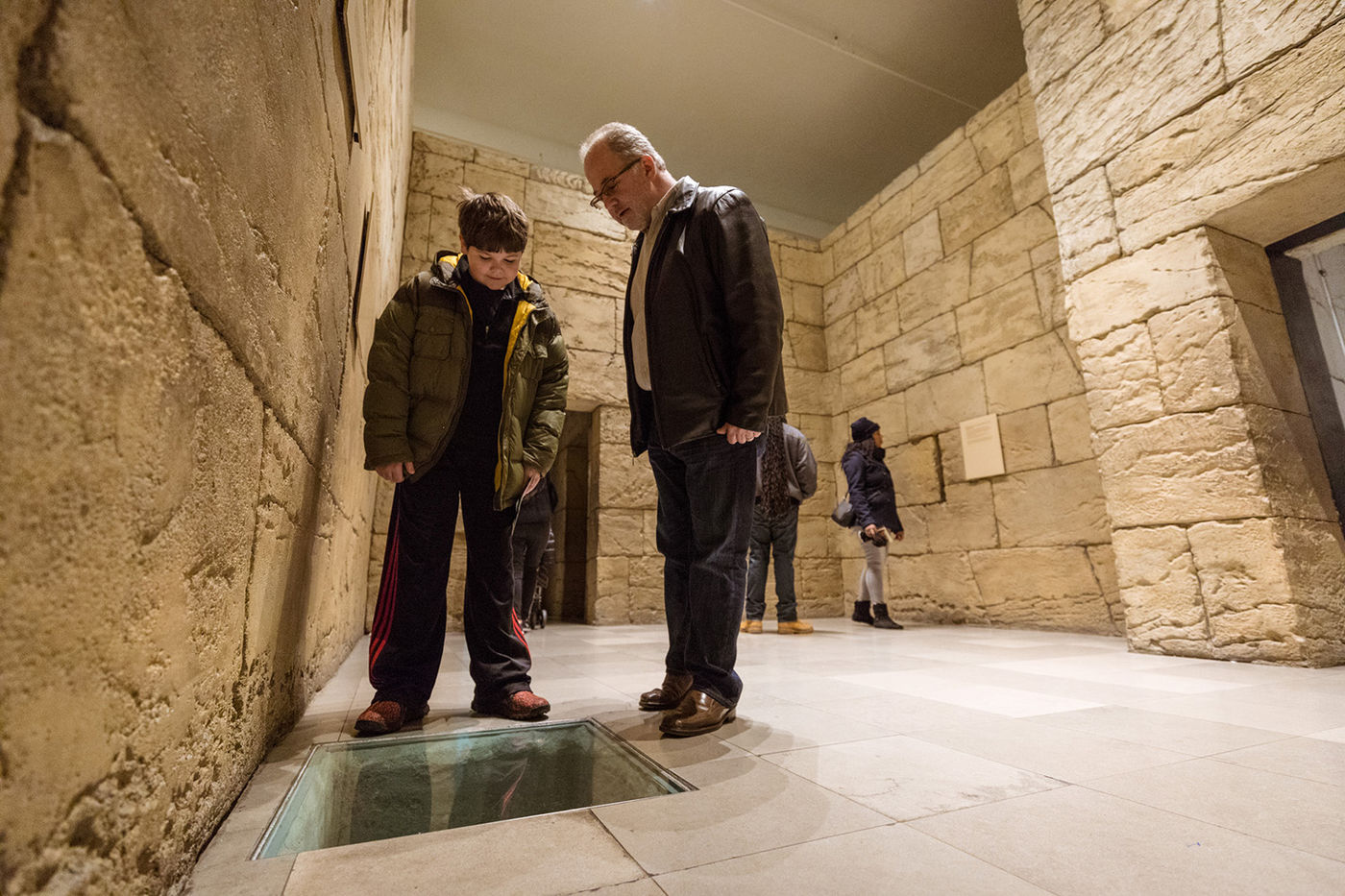
Inside Ancient Egypt
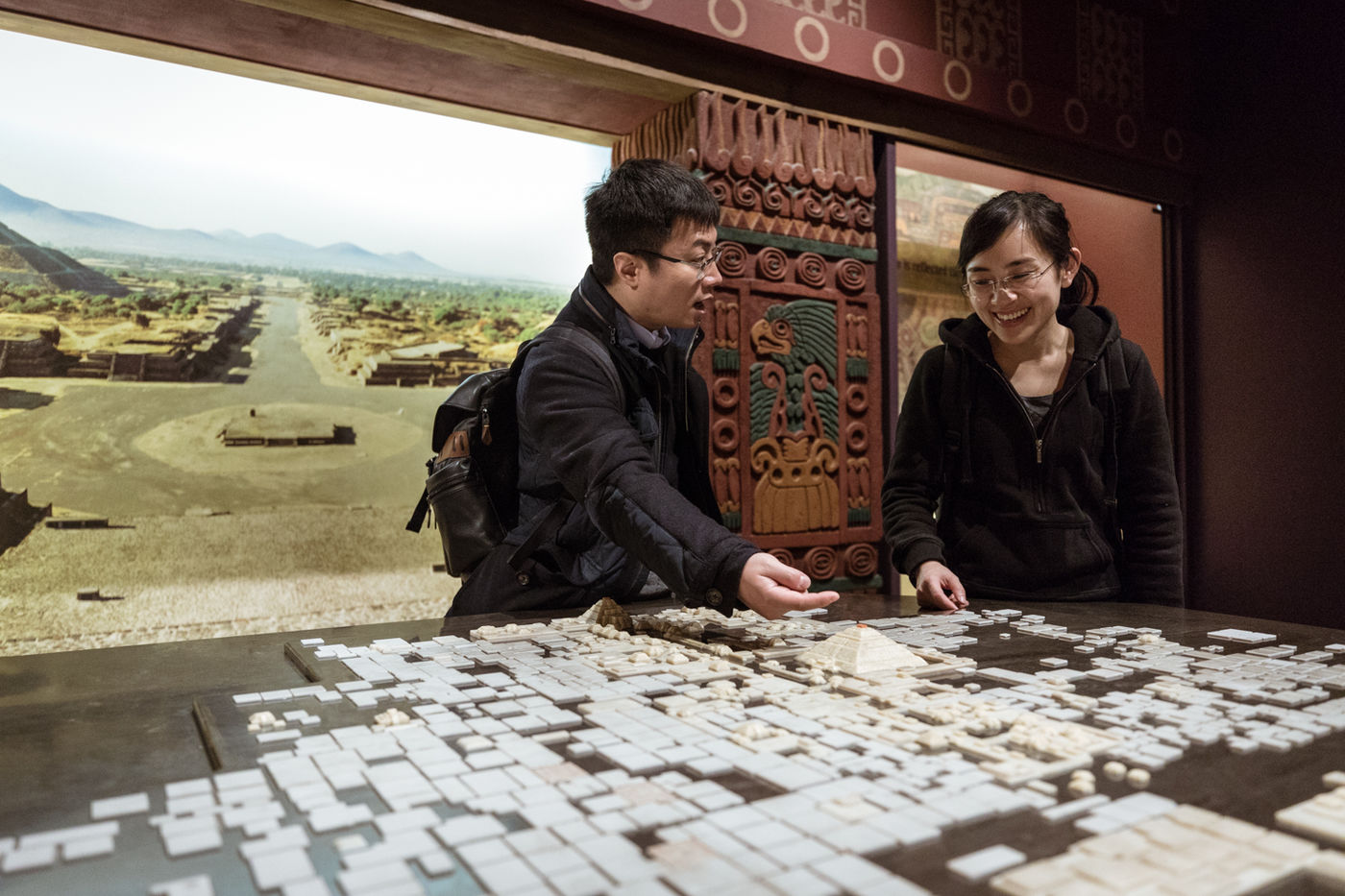
Robert R. McCormick Halls of the Ancient Americas
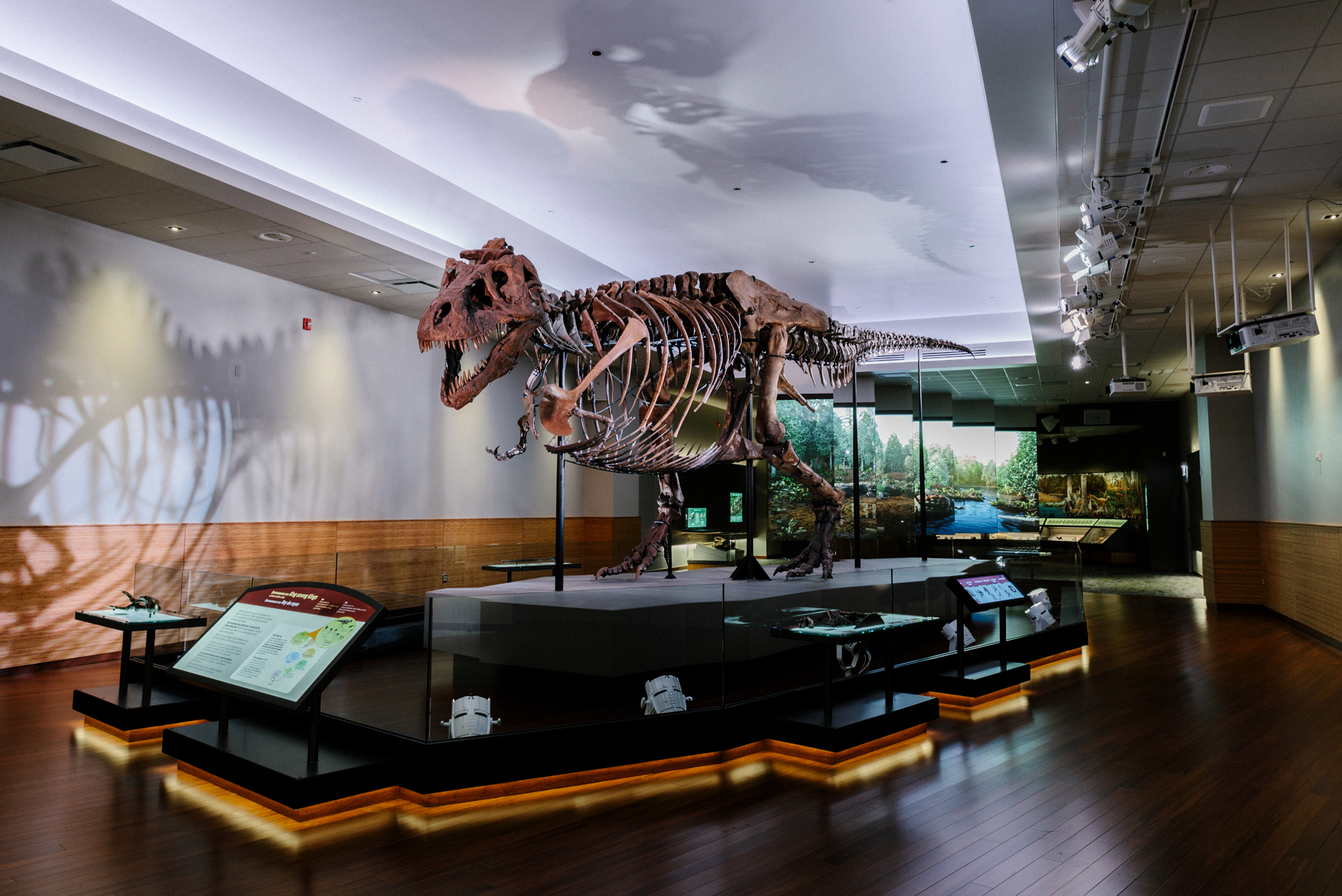
Griffin Halls of Evolving Planet & SUE the T. rex
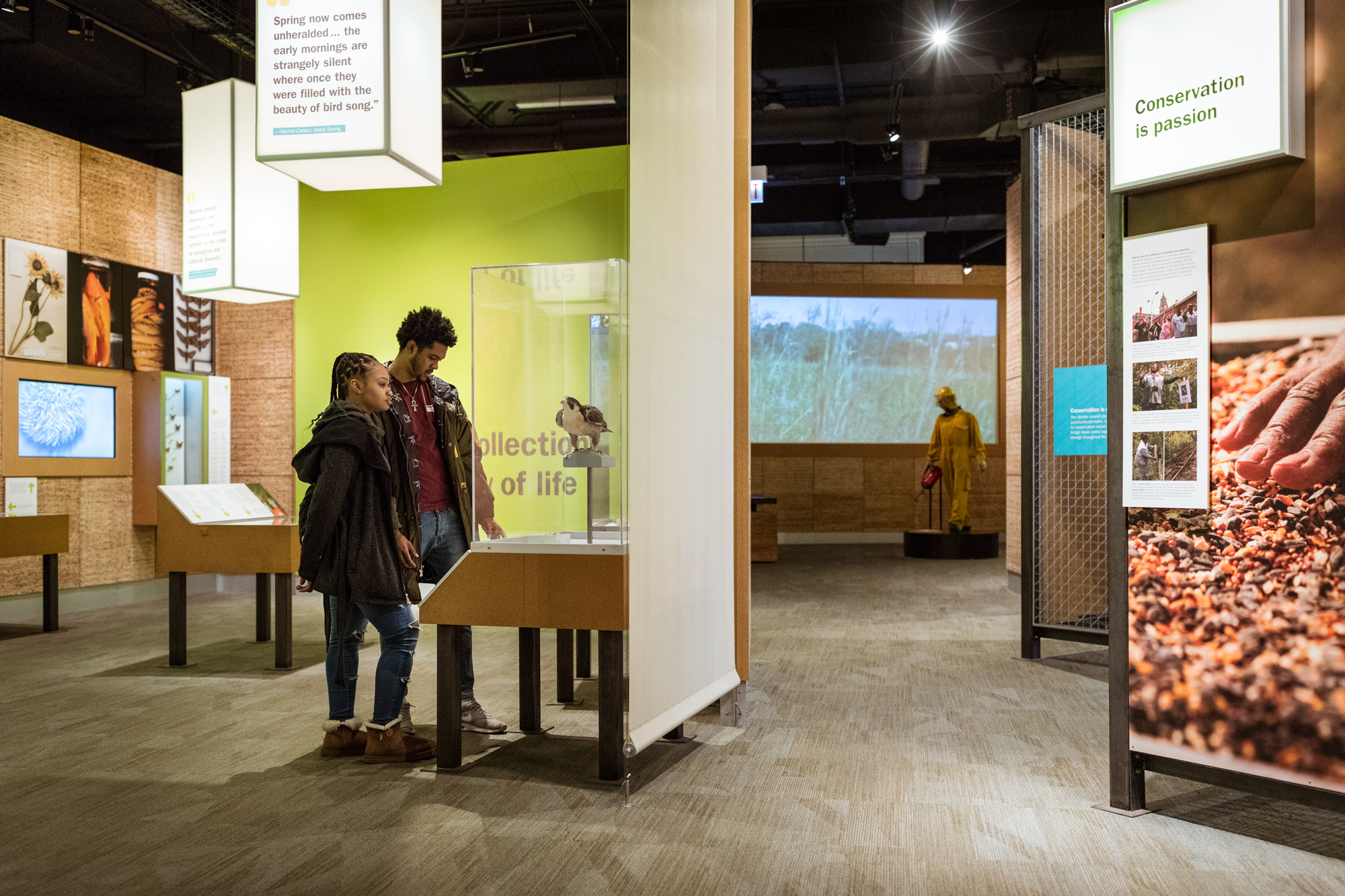
Abbott Hall of Conservation: Restoring Earth
Acknowledgments.
School learning experiences are supported by ITW.

PLAN A FIELD TRIP
- Skip to main content
- Skip to primary sidebar
- About Art Class Curator
- Media & Press
- Programs for Schools
- Member Login
- Search this website
Art Class Curator
Hands-on and Minds-curious Art Learning
New Art Criticism Book Available for Pre-Order - Experience Art 🖼️📕
November 13, 2018 Leave a Comment
The Secret to Planning a Successful Field Trip from Start to Finish
Inside: Planning a field trip? Here’s everything you need to plan a successful art field trip to a museum this year–from managing field trip chaperone behavior to scheduling the buses to preparing your students.

I know. I know! Planning a field trip can be a stressful nightmare. Coordinating with administrators, obtaining transportation, getting permission slips, collecting money, keeping track of students, recruiting chaperones, planning with the museum, and more. The list of to-dos for art field trips are nearly never-ending.
You should take your classes to an art museum. There will be paperwork and headaches and hassles, but planning a field trip is all worth it. Seriously. Let’s talk about why to do it and, more importantly, how.
Importance of Field Trip
Seeing art face to face is a singular experience. There is no way to replicate seeing an artwork in person in a classroom. There’s just not. We can do a lot with hi-resolution projectors, updated textbooks, and full-size posters. Our students can and will connect with the artworks we show them at school, but they deserve to lose their breath and feel the goosebumps that only happen when interacting with art directly.
Textures and tiny details that are lost by a lens or scanner come to life under museum lights. Artworks we’re familiar with can astonish and surprise us when we see their true scale. When I saw Picasso’s Guernica in person, I became utterly transfixed by the depth and texture of the paint and the enormous scale of the composition. The terror and heartbreak were inches away. I could see it all with devastating clarity. The emotion and impact of Guernica reached me through pictures, but I literally could not walk away when I saw it in person. My perspective shifted forevermore thanks to an experience that was impossible to achieve via screen or reproduction.

An art field trip can open our students eyes to the varieties and possibilities of art. Museums allow them to walk through history and dive into the expanse of human expression and experience cultures both familiar and otherwise firsthand. Art has the power to change lives. I’ve talked before about a museum trip that changed the course of my life . An art field trip helps mold our students into world citizens, igniting their curiosity and infusing their futures with wonder and delight.
Learning isn’t limited to the classroom and museums offer students a perfect chance to forge connection internally and externally, with their world and their peers. Classmates will converse with one another and their museum guide, making new meaning and gaining new understanding. These social and communication skills will serve them throughout their lives.
Are field trips worth it?
Budget cuts and a heavy focus on test-taking skills have made field trips seem like an unnecessary luxury rather than an important education tool. Across the country, out of school excursions are becoming less and less common , but the importance of field trip cannot be overstated. Students learn an amazing amount from taking their learning outside of the classroom. A recent study showed field trips help students develop into “civilized young men and women who possess more knowledge about art, have stronger critical-thinking skills, exhibit increased historical empathy, display higher levels of tolerance, and have a greater taste for consuming art and culture”.
In short—yes, that art field trip you’ve been thinking about is 100% worthwhile.
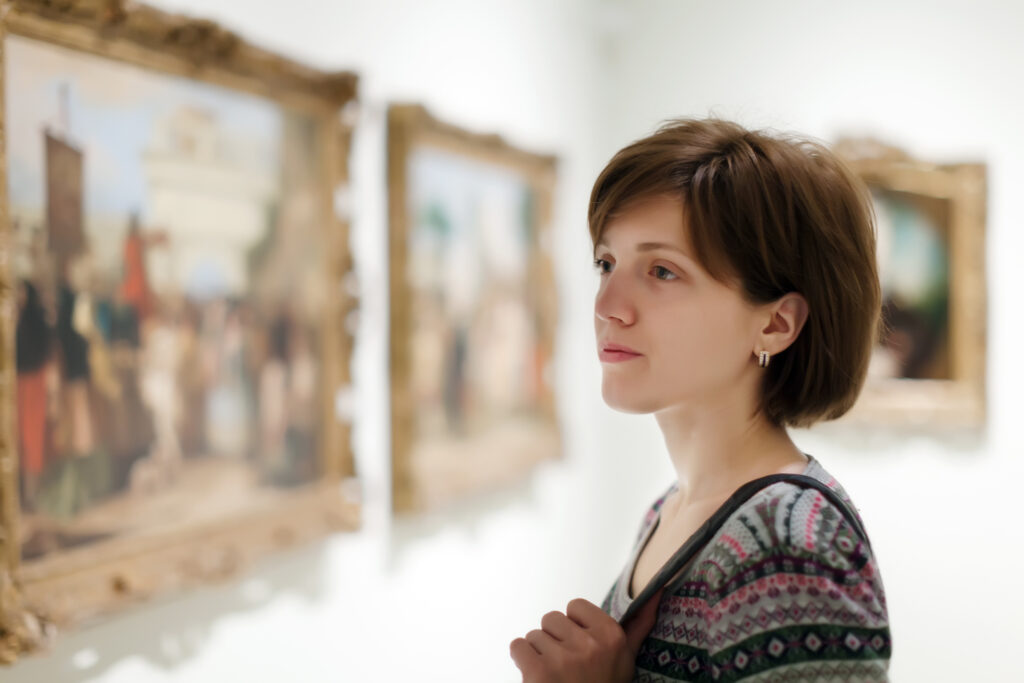
Planning a Field Trip
It’s time to clear your throat, don your strongest teacher voice, and get ready to put your ducks in a single-file line. There’s no such thing as being too prepared when it comes to planning a field trip. That’s why we created a Field Trip Packet with everything you need to plan a successful field trip from start to finish.
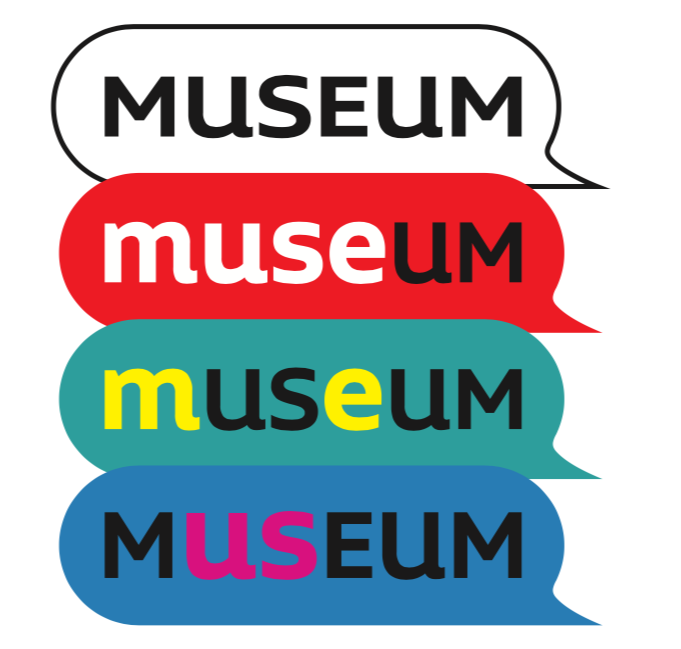
Field Trip Packet
The Field Trip Packet includes:
- Why Field Trips are Important
- Why Field Trips are Worth It
- Scheduling Tips
- Funding Tips
- Parent Communication Tips
- Busing Tips
- Chaperone Tips
- After the Field Trip Tips
- Planning Checklist
- Week of Field Trip Checklist
- Day of Field Trip Checklist
- Student Roster
- Parent Communication Template
- Permission Slip Template
For students:
- Museum & Trip Information Page
- Sketching Page
- Scavenger Hunt
- ‘I Am’ Character Poem
- Twitter Perspectives
- Exploring Place: The 5 Senses
- Trip Reflection Worksheet
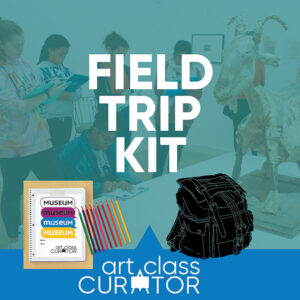
This Museum Field Trip Packet is full of documents to help you plan a successful field trip + worksheets and activities for students to complete during the museum field trip.
Scheduling your Field Trip
Check with your front office or school administration and find out what information you’ll need for planning a field trip. Usually, you’ll need to provide an itinerary of your trip. Be aware, some schools are sticklers and want near minute-by-minute schedules.
Please note, this post includes Amazon affiliate links. As an Amazon Associate I earn from qualifying purchases.
This is also a good time to find out what dates you’ll need to avoid planning a field trip on—testing dates, other field trips, assemblies, and so on. Be sure to ask when you’re allowed to leave and what time you’ll need to be back. Often, field trip times are limited by bus schedules and pickup times.
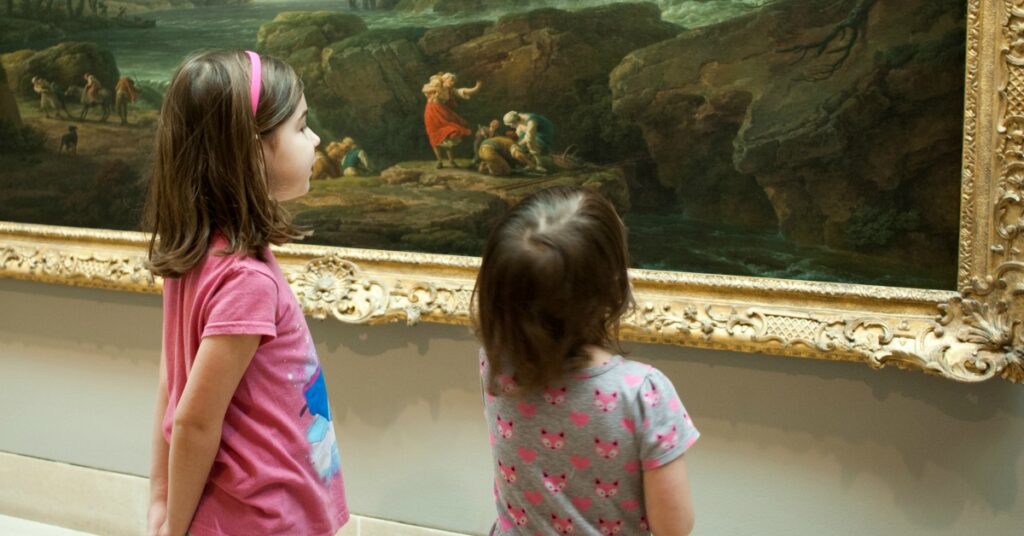
With potential dates in hand, call the art museum to book your tour. Museum staff will usually provide you with all the information you need for planning a field trip, but make sure you get these questions answered:
- How many students are allowed per group? (Museum tours usually limit the number of individuals to 15 or so, but ask your museum so you know for sure.)
- How many chaperones are required?
- What time should you arrive with students?
- Where do you park?
- Where do you enter the museum?
- Where can you eat lunch? Are there any museum policies regarding food that you need to be aware of?
- Can students go into the gift shop?
Field Trip Funding
Talk with your front office about funding your art field trip. Art museum visits are usually free, but someone needs to pay for the bus. Figure out if the school or district can pay for it or do you need to collect money from the students. Divide the amount needed by the number of students going to get the amount each will owe. If you teach at a low-income school, ask the museum if they know of any grant possibilities for funding buses.
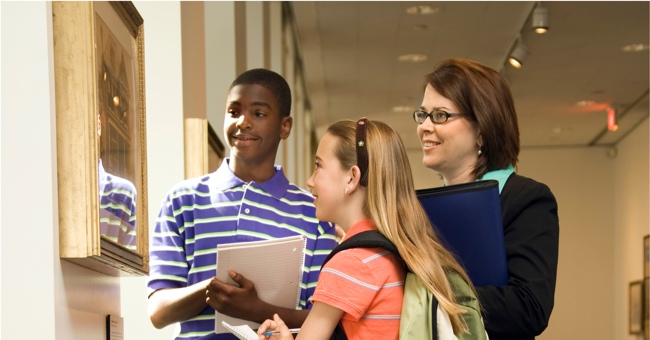
Ask your school about the best method to collect funds. Some schools do not allow teachers to give students change, in which case you’ll need to ask students to bring the exact amount. If you are allowed to make change, keep a bunch of $1 bills on hand. Keep meticulous records of the money collected. Receipt books are an easy way to keep track and can be purchased cheaply from places like Wal-Mart, Target, or an office supply store. This will make keeping track of all the money paid and owed. Trust me, you’ll be glad to have it when a student insists they already paid.
Get a big envelope to hold the funds and keep them locked in your desk or file cabinet. Ask your front office if they want it all turned it at once or at the end of each day. Print a roster of all of the students who are supposed to go on the trip to keep alongside your envelope. Make two columns alongside each name, one for money and another for permission slips.
Field Trip Permission Slip and Parent Communication
Make sure you follow your school’s protocol for sending and collecting field trip permission slips. They should have a standard form you can use. Set a deadline for your students to turn in permission slips well before the field trip and write the deadline across the top in huge, bold letters before you copy and distribute it to students.
With the field trip form, send a letter to the parents about the field trip. As a parent, I sometimes get random permission slips with no information and am lost trying to figure out what it’s for. Write a little note about how excited you are to take the kids to the museum and staple it to the field trip permission slip.
Scheduling Buses
First, figure out who is responsible for scheduling the bus. Do you do it? Does your front office do it? Does the district do it? Even if you think you know, double check! Once the art field trip is scheduled, get the bus scheduled as soon as possible. When planning a field trip, be sure to factor in driving time, getting on and off the bus, and any possible traffic into your decisions about when the bus should arrive for pickup.
When the bus arrives, be sure to get the name and cell phone number of the bus driver, as well as the bus number. You don’t want to be lost in a maze of buses with students in tow or be late getting back to school because you can’t find your driver.

Field Trip Lunch
With so many details to consider, you might forget about planning a field trip lunch, but don’t make that mistake! Consider:
- Will you be back in time for lunch or do you need to bring lunches? Work with the front office and cafeteria staff to plan sack lunches for your students.
- Do the students need to order their sack lunches in advance? If so, get the form to send home alongside the parent letter and permission slip.
- For students packing lunches, it is best to put their lunches in disposable containers so everything can be thrown away and you don’t have to worry about kids losing their favorite lunch box.
- Will the museum allow you to store lunches somewhere inside or will they need to stay on the bus?
- Where will you eat lunch? The museum staff can tell you where to go. If they don’t have a designated courtyard or cafe, consider visiting a nearby park.
- Will you allow students to buy food? Many museums have a cafe or are located in metro areas with nearby restaurants. For example, at the Dallas Museum of Art , there are always food trucks at a park across the street. When I took middle schoolers, I allowed a chaperone to accompany them to the park to buy lunch from the food trucks. If so, don’t forget to add that to your parent letter!

What to Bring with You on the Art Field Trip
- First aid kit (Often the front office or nurse will have something already prepared for you to bring.)
- Roster of all participating students
- Cell phone numbers for your chaperones, plus the school and museum phone numbers
- A map with directions to and from the destination for the bus driver—They probably know where to go, but it’s good to have ready just in case.
- An art field trip museum assignment for the students to complete. Get creative! Look at the current collection on the museum website and create a scavenger hunt or bingo cards. Encourage the students to interact with the artworks by using art appreciation worksheets .
- Pencils and paper
In addition to these things, talk with the school nurse about which students are going on the trip to find out if any medications or special precautions are necessary.
Field Trip Chaperones
Once you know how many field trip chaperones you need, recruit other teachers and parents. Your school or the museum you’re visiting will likely have their own guidelines for you to follow. As a rule of thumb for museum tours, be sure you have at least 1 adult per 12-15 kids.
Print personal copies of all the information each field trip chaperone will need—times, when and where to meet, the bus number, names of children they will watch, expected behavior, and your cell number. (Don’t forget to get their cell number as well!) Put the information in a folder or on a clipboard so it’s easy to keep everything together.
For each teacher going on the trip, make sure substitutes will be available to cover their classes. If there will be a sub in your classroom, plan your sub lessons. Pair an art appreciation worksheet with an artwork for an easy, mess-free sub lesson. You can even tie it into the art field trip by choosing one or more artworks students will see in the museum.
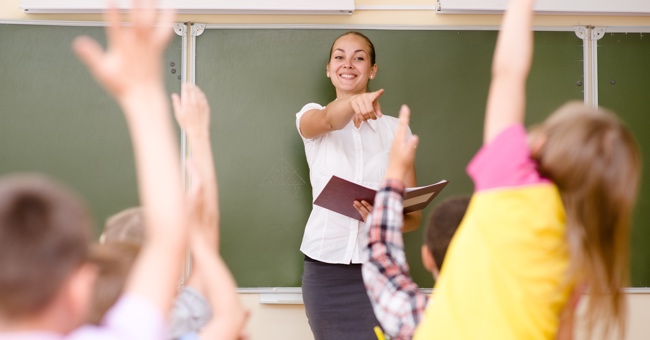
Preparing the Students for the Trip
Get your students excited for the art field trip! Beyond the novelty of getting out of school for a bit, you want them psyched for the experience too. Here are some ways to do that:
- Share pictures of the museum and the type of art they will see
- Lead art discussions with students so they can show off their awesome art interpretation skills (They’ll be sure to impress their chaperones and museum guides!)
- Discuss expected behavior. (More on this below)
- Use museum resources—museums often send great lessons and supplemental information before your art field trip. These are perfect for both pre-visit and post-visit lessons and will help students remember what they see.
- Tell students the schedule in advance what you’ll expect from them and and what they should expect regarding lunch, buses, gift shop, free time in the museum, etc. Repeat this information before you leave, on the bus, and when you arrive.
Student Behavior
As a former museum educator, I can tell you I rarely had an uncontrollable student groups. Students love field trips and the museum environment helps them stay in line. Nonetheless, discuss behavior in advance, plan and tell them consequences for misbehavior. Student behavior is a reflection on you and the school, so make sure to follow through on consequences if needed. Remember, if they respect you, they won’t want to make you look bad . Be sure students know that you’re watching and that all of the field trip chaperones will report back on their behavior.
Student Rules for Art Field Trips
- Don’t touch the art—keep an arm’s length from artworks at all times.
- Don’t yell.
- Treat the docent, museum staff, chaperones, and each other with respect.
- Participate in the lesson.
- No bags/backpacks allowed.
- No food/candy/gum/drinks
- No pens, pencils only. (The museum will provide pencils when needed.)
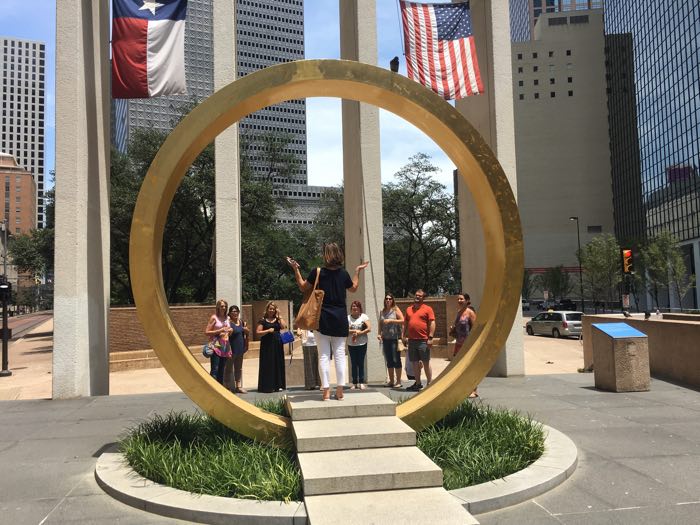
Field Trip Chaperone Behavior
Honestly, the worst behavior I saw when I was a museum teacher came from parents and field trip chaperones. Don’t shy away from including a do and don’t list in the information you give chaperones.
Don’t Do List for Field Trip Chaperones
- Talk loudly in the background with other adults.
- Treat the tour as a break. The museum teacher needs your help controlling poor behavior and inattention.
- Answer questions asked of students. It’s fun to participate in art discussions, but don’t take the opportunity away from the students. (If you’re still itching to participate in art discussions, join me every Monday at 6 pm Central on Facebook for Masterpiece Monday ! Get reminders by clicking here .)
- Play games or scroll through social media on your phone. If you aren’t respecting the learning and experience, your students won’t either.
- Lose anyone.
What to Do List for Field Trip Chaperones
- Direct student attention. Pay attention to who is or isn’t engaged. If someone isn’t paying attention, give them your best teacher look, stand by them, and talk to them between stops on the tour about their behavior.
- Model enjoyment and delight in the art. Engage with the art and the students to show them that this is a wonderful, fun experience.
- Know the info—who is in your group, where to go and when to be there, the bus number, etc.
- Constantly check to make sure all of the students in your group are present and accounted for. Count again and again.
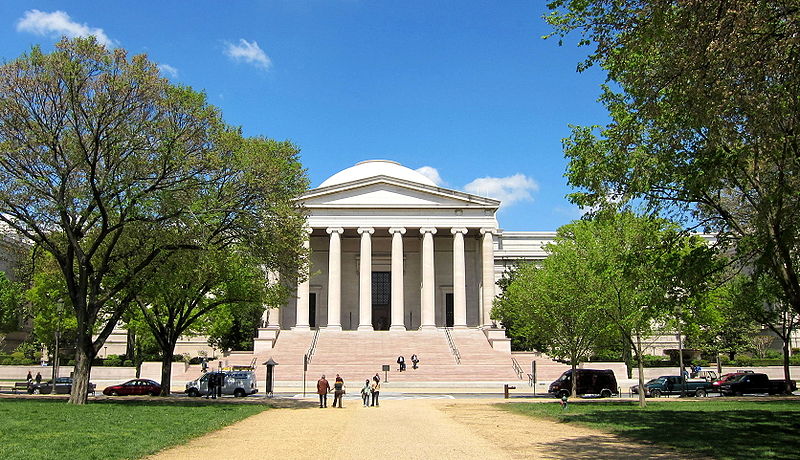
After your Art Field Trip
When planning a field trip, don’t forget to think about the follow-up! On the return bus ride or when you get back to school:
- Have students write three art field trip takeaways.
- Ask students to reflect and write a paragraph about the experience.
- Lead a class discussion about what they saw and did. (What did they like/not like? What surprised them about the experience? Do they want to go back?)
- Have students draw pictures for or write thank you letters to send to the art museum. (The museum most likely offered that tour for free and the teacher was probably a volunteer. Make their day with a lovely note.)
- Thank students for good behavior
- Follow through on the discipline plan by giving consequences for poor student behavior.
- Send a follow up letter to parents telling them about the art field trip and encouraging them to visit the art museum as a family so students can show their parents what they learned. Make sure to include information and upcoming events at the museum, as well as any free admission the museum offers.
When all is said and done, take time to reflect on the art field trip yourself. Take stock of what went well and what didn’t work. Take note what your students enjoyed and what you’d like to do differently next time. Breathe. Enjoy a job well done. Then, start planning your next artful excursion!
You May Also Enjoy These Posts:

Reader Interactions
Leave a comment cancel reply.
Your email address will not be published. Required fields are marked *
This site uses Akismet to reduce spam. Learn how your comment data is processed .
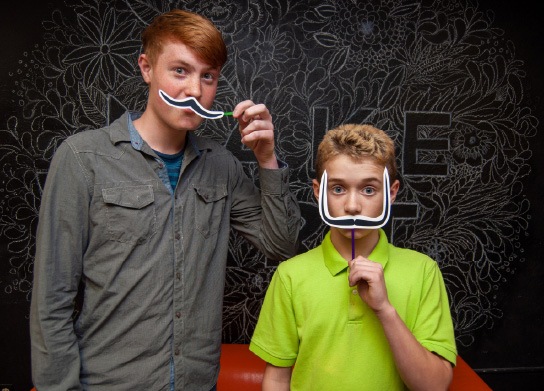
Get Art Inspiration To Your Inbox!
Free Worksheets!
*Free Bundle of Art Appreciation Worksheets*
In this free bundle of art worksheets, you receive six ready-to-use art worksheets with looking activities designed to work with almost any work of art.
Stay up to Date
Field trip activities and lesson plans.
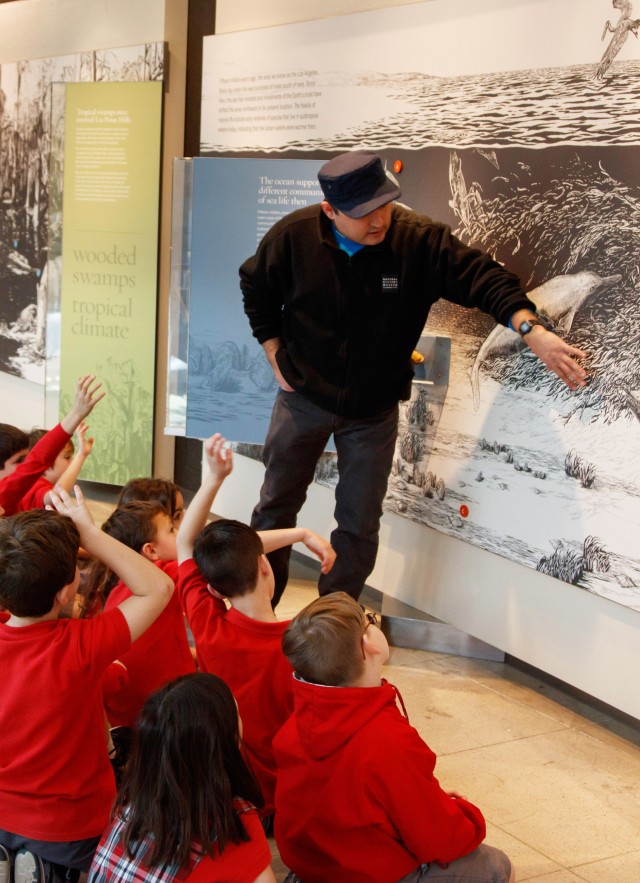
Field Trip Activities
Check out our Scavenger Hunts for student-centered learning activities to do anywhere in the museum!
Grades 2-12 | Museum Scavenger Hunt
Grades K-5 | Dinosaur Hall Scavenger Hunt
Grades 2-12 | Art of Science Scavenger Hunt
Museum Lesson Plans and Exhibition Guides
These free, printable field trip lesson plans will help your students connect classroom curriculum with their on-site museum experiences. View the exhibit halls below to find grade-appropriate lesson plans and download your copy!

Age of Mammals
Kindergarten | What is a Mammal? Identify mammal characteristics and sort them from other mammals!
Grade 2 | Mystery Mammal Observe an ancient mammal and form hypotheses about it for further investigation!
Grade 3 | Let's Investigate! Observe an ancient mammal and form hypotheses based on what you see.
Grade 4 | Investigating Adaptations Explore what adaptations are and how they reflect an animal's environment. Showcase new knowledge with a narrative presentation.
Grade 5 | Once Upon A Time… Let ancient mammal melodrama inspire a narrative script to perform with the class!
Grade 6 | Moving and Shaking Examine the effects of plate tectonics on the evolution of mammals. Watch the video associated with this lesson plan!
Grade 7 | Super Selection Examine natural selection and conduct a research project to explore what selection pressures might have influenced the evolution of a particular species represented in this exhibit.
Grade 8 | Postulating Pressures Research a mammal's natural history to try and reveal the selection pressures that drove its evolution, then share findings with a research project.
Grades 9 - 12 | Global Processes Review evolution by natural selection, then conduct a research project about a specimen in our halls to discover its evolutionary history. Watch the video associated with this lesson plan!
Becoming Los Angeles
Grades K - 5 | History Social-Science Standards Connections in Becoming Los Angeles
Grades 2 - 5 | Found History Get your students' creativity flowing by using exhibit text to create their own unique poetry.
Grade 3 | Continued Traditions Explore traditions of the Gabrielino-Tongva people and how those traditions live on today. Become a museum archaeologist to examine artifacts and write, draw, and record your findings.
Grade 4 | Coming to California Discover how 49ers traveled to California during the Gold Rush by examining museum objects and historical photographs. Investigate one migrant's journey to California in search of riches.
Grades 6 - 12 | Found History Creative writing and critical thinking come together in this L.A. history-inspired, found poetry exercise.
Bird Hall
Grades K - 5 | Bird Hall Teachable Moments Quick activities to guide student exploration in the Bird Hall.
Kindergarten Grade 1 Grade 2 Grade 3 Grade 4 Grade 5
Dinosaur Hall
Grades K - 12 | Dinosaur Hall 101 This PowerPoint walks you through the overarching stories in the Dinosaur Hall to make the most of your visit.
Pre K - K | Paleontological Practice Explore dinosaurs using a KWL approach and make guided observations using a scavenger hunt for the Dinosaur Hall.
Grade 1 | Adaptation Sensation Compare adaptations of modern-day animals with fossil specimens to determine how ancient animals used to survive.
Grade 2 | Decoding Dinos Compare and contrast dinosaurs with other animals to decode their lost legacy and formulate hypotheses about how they used to live.
Grade 3 | The Past Through the Present Discover how even life millions of years ago varied depending on the environment it lived in.
Grade 4 | The Dino Diner Use math and science to deliver excellent customer service to some paleo patrons!
Grade 5 | What Killed the Dinosaurs? Consider multiple hypotheses and present evidence for the demise of the dinosaurs with this research-based writing exercise.
Grades 6 - 8 | Dinosaurs and Definitions Through a research project, examine vocabulary using context to infer the meaning of new words.
Grade 6 | Mesozoic Measurements Convert the measurements taken in the Dinosaur Hall to create a graph comparing three species of dinosaurs.
Grade 7 | Modern Detectives for an Ancient World Use observations to form hypotheses and then revise it based on new evidence and research.
Grade 7 | Shaping Dinosaurs Use dinosaurs as a topic to understand tessellations and how to calculate area and perimeter.
Grade 8 | Sizing 'em Up Or rather... down. Draw a dinosaur specimen to scale after measuring its length, width and estimating its height.
Grades 9 - 12 | Amazing Adaptation Use a Tree Map to connect observations, inferences, and conclusions about an observed specimen in the Dinosaur Hall, then consider how natural selection played a role in that specimen's evolution.
Gem and Mineral Hall
Gem and Mineral Hall Vocabulary Sheet
Pre K | A Rocky Rainbow Explore the colorful world of gems and minerals!
Pre K | Math Rocks! Introduce measuring and graphing in a hands-on way using our specimens.
Pre K | Natural Opposites Rocks are a great place to discover naturally occurring opposites.
Grades K - 5 | Gem & Mineral Hall Teachable Moments Quick activities to guide student exploration in the Gem and Mineral Hall.
Kindergarten | Describing and Deciding Practice using new adjectives in a Gem and Mineral Hall scavenger hunt!
Kindergarten | Exploring Size Use our natural world to reinforce the concept of "big" and "small."
Kindergarten | Guided Discovery Consider the components of land. What do we know? What would we like to know?
Grade 1 | Let's Talk Rock Use scientific vocabulary to practice making observations
Grade 1 | Categorizing Collections Sort rocks and minerals into different groups by their attributes.
Grade 2 | An Adjective Habit Use scientific vocabulary to record and communicate observations.
Grade 2 | In Your Estimation Compare estimates with actual measurements of Museum specimens.
Grade 3 | Investigating Minerals Inspire inquiry and investigation with a mineral's unique structure and beauty.
Grade 4 | A Miner's Life for Me! Consider the daily trials of a miner during the California Gold Rush.
Grade 4 | California's Geologic Regions Through mineral investigation, discover California's four unique geologic regions.
Grade 4 | Properties of Minerals Examine mineral properties as a tool for identification.
Grade 4 | The Rock Cycle Compare and contrast the three major types of rocks in this probe into the rock cycle.
Grade 5 | Life of a Gemstone Articulate a mineral's life story from formation to excavation.
Grade 6 | Natural Beauty In this interdisciplinary lesson set, practice geometric reasoning and artistic expression while gaining appreciation for the natural beauty of rocks and minerals.
Grade 7 | How Old is the Earth? Introduce Earth's history through vocabulary building, observation and discussion.
Grade 7 | Lighting Up the Gem & Mineral Hall Discover the properties of light by examining their interaction with gems and minerals.
Grade 8 | Building Blocks of Minerals Explore the fundamentals of chemistry and engage in inquiry through examining a mineral's composition and structure.
Grade 8 | You Can't Fool Me! Examine the chemical and physical properties of matter by revealing their application to real life situations.
Grade 9-12 | Chemistry See chemistry in action in this adaptable lesson set that examines mineral composition and formation.
Grade 9-12 | Earth Science Classify minerals by observable characteristics and relate mineral properties to the environments in which they form.
Mammal Halls
Grades K - 5 | Mammal Halls Teachable Moments Quick activities to guide student exploration in the Mammal Halls.
Nature Gardens
Pre-K | Leaf Sorting Practice categorization by comparing, contrasting, and drawing the native plants in our Nature Gardens!
Grades K – 12 | Squirrel Observations Observe, collect, and analyze data on a popular animal that's easy to find in a schoolyard!
Kindergarten | How We Survive Investigate the four basic needs--air, water, food, and shelter--of living organisms with observations in our Nature Gardens!
Kindergarten | Living and Non-Living Determine what makes something living or non-living with a journaling or photo-taking activity in our gardens that turns into a collage back in the classroom.
Kindergarten | Move It, Move It! Mimic animal movements and apply what you observe about motion in our Gardens to drawing and describing.
Grade 1 | Plant Parts Discover the parts of a plant by growing them in the classroom, then comparing your observations to the plants in our Nature Gardens!
Grades 2 – 12 | Sounds of Nature Practice listening and observing nature to understand more about the biodiversity of our city.
Grade 2 – 3 | Marvelous Metamorphosis Introduce students to complete metamorphosis while looking for ladybug eggs, larvae, pupae, and adults in the Nature Gardens!
Grade 7 | Insects and Biodiversity Explore L.A.'s biodiversity through bugs and introduce classification.
Grades 9 – 12 | Ecology and Energy Flow Explore how energy moves between organisms in our Nature Gardens!
Grades 9 – 12 | P lant Parenthood Observe how artificial selection and natural selection play out in our Nature Gardens!
Nature Lab
Grades K – 12 | My Wild L.A. Tell your story about L.A. nature and use it to develop a narrative work and inspire a research project!
- Apply to UMaine

Versant Power Astronomy Center and Maynard Jordan Planetarium
Why take a field trip.
- Read the National Research Council of the National Academies Report on Informal Science Learning Experiences
Museum* Field Trips as an Adjunct to Classroom Instruction
Why Take Field Trips?
Field trips offer opportunities to students that they may not have known existed, and expose them to learning experiences that can not be duplicated inside the classroom. These “out-of-school” experiences have been a tradition since the earliest schools were founded.
A number of factors have come into play in the past 10 years to interfere with the field trip element of the educational experience. Decreased funding across all government departments and educational systems have forced administrations to resort to the most economical educational experiences. Inflationary prices in fuel and transportation services have made the cost of traveling to a remote location nearly prohibited with prices for a school bus well over $100 and frequently over $200 for a single trip. Efforts to improve the educational system within the State of Maine and throughout the United Stated has resulted in a huge increase in the workload of teachers as they attempt to incorporate new curriculum plans and education methodology.
All of these factors combined, reduce the number of school that are taking field trips to museums, planetariums, and cultural centers, consequently depriving many students of a experiences that would enrich their education and, for some, provide motivation and insights that suit their learning style.
Although books and classrooms offer wonderfully comprehensive educational learning experiences, the citizen of the 21st century will be expected to learn and re-learn from their working and living environment. The skills for critical observation and comprehension from a person’s surroundings are essential lifelong learning objectives.
At the University of Maine, public school classes have visited a variety of different sites to enhance their learning experience ranging from a walk through the hockey arena to a tour of the universe at the planetarium, and a tour through UMaine’s unique museums. The feedback that we have received from the leaders of these groups suggests that this is a priceless opportunity for teaching with exposure to the “real thing”. It is also a chance for the students to get a first impression of the University of Maine and begin to think of it as an option for their educational future. The UMaine resources are maintained to offer a maximum learning experience to public visitors at a minimum of user cost. Where admission fees or use fees are required they have been kept low and reflect only a fraction of the expense to maintain the visitor experience.
In light of the precarious status of the field trip programs within the public school, the planetarium staff would like to provide as much support as possible for teachers endeavoring to take field trips as much as possible. The following text is from a booklet published by Museum Institute for Teaching Science (MITS), with the intention of explaining museum field trips (including field trips to planetariums). You are welcome to copy any of this text for use in field trip planning.
“A field trip consists of a group of students and their teacher going to a site other than their classroom to increase their understanding of and exposure to curriculum related topics. The trip may include visits to a facility to explore its collections, a walking tour to learn about some aspect of the surroundings or some other type of educational experience. The field trip should augment content, skills and processes as recommended for their grade level by the Massachusetts Frameworks.
MITS feels that field trips planned by teachers to augment their available classroom resources are an integral part of a curriculum for many schools. Such field trips do, or can be made to, complement the Massachusetts Frameworks and local curriculums. We have prepared this memo for museum educators to use to inform their administrators, trustees and other supporters about the value of field trips to their museum for the students of Massachusetts in hopes that they will inform the Board of Education. The Board needs to hear this from thoughtful, respected members of the community.
The case for field trips The PALMS (Partners Advancing the Learning of Mathematics and Science) project at the Massachusetts Department of Education is based on the assumption that partners from the community increase the resources available for the education of students in schools. Museums were originally and are still among these partners.
The National Science Foundation and the US Department of Education, in their funding of school/museum programs, mandate that they be tied in to the educational reform standards. These include field trips.
The National Science Education Standards under teaching standard D states that “the school science program must extend beyond the walls of the school to include the resources of the community.”
The Massachusetts Frameworks for the Arts reads: Students will Participate in the Community’s Cultural and Artistic Life. A question to be explored under this is: What does my community offer to people who enjoy the arts?
Congress approved $40 million in FY98 for the US Department of Education’s program “21st Century Community Learning Centers.” This program supports efforts to expand learning beyond the school day and acknowledges the importance of building partnerships between schools and community organizations, including museums. It explicitly encourages schools to use the resources of community organizations.
Benefits to the Students Field trips extend the resources available to students in the classroom. They expand learning by giving the student access to the real thing. They illustrate and permit experience with what has been read about, seen on television or computer software. Teachers include field trips in their units of study for this purpose. Field trips are linked to the classroom because they are contextualized within the classroom curriculum. Teachers choose from museum programs and exhibits to expand and reinforce desired concepts.
Museums have the artifacts and exhibits that provide opportunities for learning through direct experience, reaching the student who does not learn as well from traditional modes of teaching. Museums provide opportunities for students to practice observation skills which enhance the hands-on inquiry mode teaching. The Common Chapters of the Massachusetts Frameworks state that learning must be for all students. They chart various types of intelligence giving examples from the various frameworks which address these types of learning. They also give examples of strategies which may be used to help all students learn. Many of these strategies can be augmented and made more relevant through planned field trips. Field trips can be used to provide students with research opportunities around a topic of study. They provide a setting for the practice of observational skills, to awaken curiosity and inquiry.
Field trips can contribute to many different disciplines of the school curriculum and demonstrate that mathematics is not separate from art, from science, from history, etc. The world is not segregated into neat little boxes with labels such as social studies and science. A field trip is an opportunity for learning in an interdisciplinary setting, to bring it all together and to start the process of thinking.
Field trips are appropriate for all grade levels of students. They are an opportunity for students to visit cultural resources which they may not have known existed. They provide a shared experience for all students. They provide an entrance into an unfamiliar world to which the students may be able to introduce their parents.
Lifelong Learning The Frameworks advocate learning and teaching so that the opportunities for lifelong learning are opened up to students. For many students the school field trip is the only opportunity to visit a museum. It is one more way to provide equal opportunity for all the students.
Field trips introduce students to different worlds which can be enjoyed throughout their lives. School field trips provide an organized learning experience that is different from visiting a museum for entertainment purposes with parents or Scouts.”
* The term museum should be understood to include all informal education institutions and cultural resources maintaining a collection, and education staff and offering education programs to the public. Therefore the term includes botanical gardens, aquariums, zoos, historical sites, nature centers, planetariums, etc. all of which are considered part of the informal education network offering field trips.
Winter is here! Check out the winter wonderlands at these 5 amazing winter destinations in Montana
- Travel Guide
How To Plan A Field Trip Lesson Plan
Published: December 1, 2023
Modified: December 28, 2023
by Trescha Prescott
- Plan Your Trip
Introduction
Field trips are an invaluable educational experience that can greatly enhance a student’s learning journey. They provide an opportunity for students to explore the world beyond the confines of their classrooms and engage with real-life examples of the concepts they have been studying. Whether it’s a visit to a museum, a nature reserve, an historical site, or a local business, a well-planned field trip can bring learning to life in a way that textbooks simply cannot.
The purpose of this article is to guide educators and trip organizers on how to plan an effective and engaging field trip lesson plan. From choosing a suitable location to organizing transportation and ensuring student safety, every aspect of the planning process will be covered. Additionally, we will explore strategies for preparing students, creating interactive lesson plans, and assessing their learning outcomes.
Field trips have been proven to increase student engagement, motivation, and retention of knowledge. They provide a hands-on approach to learning and allow students to make connections between what they learn in the classroom and the real world. By immersing themselves in new environments and experiences, students develop critical thinking skills, observational skills, and gain a deeper understanding of the subject matter.
However, organizing a field trip can be a complex task. It requires careful planning, coordination, and attention to detail. This article aims to simplify the process and provide practical tips and guidelines to ensure a successful and enriching field trip experience for both teachers and students. Let’s dive in and discover how to plan a field trip lesson plan that will leave a lasting impact on your students.
Purpose of the Field Trip
The purpose of a field trip goes beyond simply providing students with a break from the classroom. It serves as a way to broaden their horizons, deepen their understanding of a subject, and foster connections between theoretical concepts and real-world applications. A well-defined purpose ensures that the field trip aligns with the curriculum and learning objectives, making it a valuable and meaningful experience for the students.
One of the main purposes of a field trip is to provide students with a hands-on learning experience. By immersing themselves in a real-world setting, students can engage all their senses and interact with the subject matter in a tangible way. This active participation not only enhances their understanding but also encourages curiosity and critical thinking skills.
Field trips also aim to expose students to new environments, cultures, and perspectives. They broaden students’ horizons by allowing them to step outside their comfort zones and experience different contexts. This exposure fosters empathy, cultural awareness, and an appreciation for diversity.
Another purpose of a field trip is to connect classroom knowledge to real-life applications. Students often struggle to see the relevance of what they are learning in school to their everyday lives. By visiting relevant sites and engaging with professionals in the field, students can witness firsthand how the concepts they learn in class are applied in the real world. This connection can be a powerful motivator, sparking deeper interest and enthusiasm for the subject.
Furthermore, field trips provide an opportunity for students to develop essential life skills. They learn to navigate new environments, work in teams, and communicate effectively with peers, teachers, and professionals they encounter during the trip. These skills are invaluable for their personal and professional growth.
Overall, the purpose of a field trip is to enrich the learning experience by providing students with an immersive, interactive, and multi-dimensional learning opportunity. It encourages curiosity, critical thinking, cultural awareness, and the development of essential life skills. With a clear understanding of the purpose, educators can plan and execute a field trip that meets the specific needs and objectives of their students.
Choosing a Field Trip Location
Choosing the right field trip location is crucial to ensure that the experience is not only educational but also engaging and relevant to the curriculum. When selecting a location, consider the following factors:
Curriculum Relevance: Look for field trip locations that align with the topics or subjects being taught in the classroom. For example, if studying history, a visit to a local historical site or museum would be appropriate. If studying biology, a trip to a nature reserve or zoo would be more suitable. The goal is to reinforce and complement what students are learning in class.
Variety and Diversity: Aim for a diverse range of locations throughout the academic year to expose students to different environments and perspectives. This can include museums, cultural centers, nature reserves, factories, and local businesses. The variety will keep the field trips fresh and exciting, and students will have the opportunity to explore a wide range of subjects and interests.
Accessibility: Consider the proximity and logistical aspects of the location. Choose a location that is easily accessible for both students and teachers. Consider transportation options, travel time, and any potential barriers that may hinder the trip. If necessary, explore partnerships with local transportation services or arrange for parent volunteers to assist with transportation.
Safety and Security: Prioritize the safety and security of the students when selecting a field trip location. Ensure that the location has appropriate safety measures in place and is suitable for children of the targeted age group. Research the location’s track record for safety and read reviews from other educators who have visited before.
Interactive and Engaging Experiences: Look for field trip locations that offer interactive and hands-on experiences. These experiences allow students to actively participate and engage with the subject matter. For example, a science museum might have interactive exhibits and workshops, while a local farm might offer opportunities for students to feed animals or plant seeds.
Budget-Friendly Options: Consider the financial constraints of the school or organization while selecting a field trip location. Some locations offer discounted rates for educational groups or have grants available for schools. Additionally, look for local options to minimize transportation costs. Seek out partnerships with community organizations or local businesses that may be willing to sponsor or support the field trip financially.
By considering these factors, educators can choose field trip locations that enhance learning, engage students, and provide them with unique and memorable experiences outside of the classroom. The selected locations should align with curriculum goals, offer variety, prioritize safety, promote interactivity, and remain budget-friendly. Finding the right balance of educational and engaging experiences will ensure a successful and impactful field trip.
Getting Permission and Funding
Once the field trip location has been selected, the next step is to obtain permission from the necessary authorities and secure funding for the trip. Here are some important steps to consider:
Seeking Administrative Approval: Start by presenting the field trip proposal to the school administration or relevant decision-making body. Clearly outline the educational goals, learning outcomes, and logistical details of the trip. Emphasize the value and relevance of the experience to the students’ academic and personal growth. Address any concerns or questions that administrators may have, and be prepared to provide supporting documentation or evidence of the educational benefits.
Communicating with Parents and Guardians: Once approval is granted, it is crucial to inform parents or guardians about the field trip. Create a comprehensive permission form that outlines the details of the trip, including the date, location, itinerary, anticipated costs, and any additional information such as transportation arrangements, lunch arrangements, and safety precautions. Provide ample time for parents to review and sign the permission forms, and be available to address any questions or concerns they may have.
Securing Funding: Field trips can often incur expenses, including admission fees, transportation costs, and meals. It is essential to explore funding options to make the trip feasible for all students. Start by investigating if the school or organization has a budget set aside for field trips or if there are grants available specifically for educational outings. Additionally, consider partnering with local community organizations, businesses, or parent-teacher associations to secure sponsorships or donations. Fundraising activities, such as bake sales or car washes, can also help generate funds for the trip.
Requesting Scholarships or Financial Assistance: Recognize that not all students may be able to afford the cost of the field trip. It is essential to provide equal opportunities for participation by offering scholarships or financial assistance. Communicate with the appropriate school staff, such as the guidance counselor or principal, to identify students who may require financial support. Research local organizations or foundations that provide scholarships for educational experiences and submit applications on behalf of the students in need.
Establishing a Payment Deadline: To ensure timely collection of funds and finalize the logistics of the trip, establish a deadline for receiving permission slips and payments. Clearly communicate the deadline to parents, and provide reminders leading up to it. Consider offering payment options to accommodate families who may need more flexibility, such as installment plans or electronic payment methods.
By following these steps, educators can navigate the process of obtaining permission and securing funding for the field trip. Open and transparent communication with school administrators, parents, and guardians is vital. Exploring funding options and addressing financial barriers will help ensure that all students can participate in this enriching educational experience.
Preparing the Students
Before embarking on a field trip, it is crucial to properly prepare the students for the experience. By doing so, educators can maximize the learning opportunities and ensure that students make the most of their time at the chosen location. Here are some key steps to consider when preparing the students:
Introduce the Field Trip Objectives: Start by clearly communicating the objectives of the field trip to the students. Explain why the chosen location was selected and how it aligns with their current studies. Discuss the anticipated learning outcomes and emphasize the importance of active engagement during the trip.
Background Knowledge: Provide students with the necessary background knowledge to fully grasp the context of the field trip. Conduct pre-field trip lessons or activities that introduce the concepts, themes, or historical significance associated with the location. This foundational knowledge will enhance their understanding and enable them to make connections during the visit.
Site-Specific Information: Familiarize students with the selected location. Share information about its history, significance, key features, and any specific rules or guidelines that need to be followed. Consider showing relevant videos, images, or virtual tours to give students a visual overview of what to expect.
Engage in Pre-Trip Discussions and Activities: Encourage students to research and discuss the field trip destination in class. Assign pre-trip activities, such as reading articles, watching documentaries, or engaging in group discussions, to deepen their understanding and generate excitement for the upcoming visit.
Set Expectations and Behavior Guidelines: Clearly outline the expectations and behavior guidelines that students should adhere to during the field trip. Discuss appropriate conduct, respect for the location and its staff, and the importance of safety precautions. Establish consequences for non-compliance and reinforce the idea that the field trip is a privilege that requires responsible behavior.
Address Safety Concerns: Identify and address any potential safety concerns with the students. Discuss emergency procedures, buddy systems, and the importance of staying with the group and following instructions. Remind students of any specific health or allergy considerations and ensure that necessary medications are readily available.
Prepare Necessary Materials: Depending on the field trip objectives, students may need to bring certain materials such as notebooks, cameras, or clipboards. Provide a list of required items beforehand so that students can come prepared. Additionally, create worksheets or assignments that require students to actively observe and document their experiences during the trip.
Engage in Pre-Trip Reflections: Encourage students to reflect on what they hope to learn or experience during the field trip. Allocate time for students to share their expectations and insights with their peers. This reflection helps set intentions and primes students to actively engage with the trip’s objectives.
By adequately preparing the students for the field trip, educators lay the foundation for a successful and meaningful learning experience. Through background knowledge, discussions, setting expectations, and addressing safety concerns, students can approach the field trip with enthusiasm, curiosity, and a readiness to actively engage in their learning journey.
Creating a Lesson Plan
A well-designed lesson plan is essential to ensure that the field trip serves as a valuable educational experience. It helps guide teacher-led discussions, activities, and assessments before, during, and after the trip. Here are key steps to consider when creating a lesson plan for a field trip:
Establish Learning Objectives: Clearly define the learning objectives you want to achieve through the field trip. What specific knowledge or skills do you want students to acquire or demonstrate? Align the objectives with curriculum standards and make them measurable, allowing for assessment of student progress.
Pre-Trip Activities: Develop pre-trip activities that introduce the concepts, themes, or historical background of the field trip location. These activities can include readings, videos, discussions, or hands-on projects. Such activities provide a foundation for students to build upon during the field trip.
During-Trip Engagement: Outline specific activities or discussions that will take place on-site during the field trip. Incorporate opportunities for active exploration and observation to deepen students’ understanding. Consider organizing guided tours, interactive workshops, or scavenger hunts to keep students engaged and focused on the objectives.
Post-Trip Reflections and Assessment: Plan post-trip activities that allow students to reflect on their experiences and consolidate their learning. Provide opportunities for students to share their observations, insights, and questions. Assess their comprehension and critical thinking skills through assignments, discussions, or presentations that connect the trip to the broader curriculum.
Curriculum Integration: Ensure that the lesson plan integrates the field trip seamlessly into the broader curriculum. Find ways to connect the learning experiences from the trip to classroom instruction, projects, or assessments. Highlight the relevance of the field trip to the subject matter and facilitate the transfer of knowledge between the classroom and real-world contexts.
Differentiated Instruction: Consider the diverse needs and learning styles of your students. Incorporate strategies to differentiate instruction during the field trip, such as providing different types of activities or assessments to accommodate varying abilities or interests. Adapt the lesson plan to address the specific needs of individual students or groups.
Collaboration and Reflection: Foster collaboration among students during the field trip by encouraging group work, discussions, and sharing of observations. Additionally, allocate time for post-trip reflection sessions to allow students to process and articulate their learning experiences. This promotes metacognition and the development of critical thinking skills.
Resources and Materials: Identify the resources and materials needed to implement the lesson plan effectively. This may include worksheets, visuals, technology tools, or reference materials. Ensure that all necessary resources are readily available and make any required arrangements prior to the field trip.
By following these steps and considering the unique circumstances of your students, you can design a comprehensive lesson plan that optimizes the educational value of the field trip. Remember, a well-designed lesson plan not only enhances the learning experience but also helps students make meaningful connections between their experiences on the trip and the broader curriculum.
Organizing Transportation
Organizing transportation for a field trip is a key logistical aspect that requires careful planning and coordination. Here are some important steps to consider when arranging transportation for your field trip:
Evaluate Transportation Options: Assess the transportation options available to you, keeping in mind the number of students, distance to the field trip location, and any specific needs or restrictions. Common options include school buses, public transportation, chartered buses, or arranging for parent volunteers to carpool. Consider the costs, safety, and convenience of each option.
School Bus Transportation: If using school buses, contact your school’s transportation department to inquire about availability, requirements, and any specific guidelines you need to follow. Provide them with the date, destination, and estimated number of students. Be sure to confirm and reconfirm the bus reservation closer to the field trip date.
Private Transportation Companies: If opting for chartered buses or private transportation companies, research and compare different companies to find the best fit for your needs. Consider their reputation, reviews, safety records, and pricing. Book the transportation well in advance to secure availability.
Permission Slips and Liability: Include transportation-related information in the permission slips or forms that parents or guardians need to sign. Clearly communicate the mode of transportation, departure time and location, and any important information related to transportation logistics. Ensure that liability waivers are included to protect both the school and transportation provider.
Seat Assignments and Grouping: Depending on the size of the group and the transportation arrangement, consider assigning seats or grouping students. Distribute seat assignments or groupings in advance to avoid chaos during departure and to ensure that students are seated with appropriate supervision.
Supervision and Chaperones: Plan for an adequate number of adult chaperones to accompany the students during the field trip. Assign responsibilities and clearly communicate expectations to chaperones regarding student supervision, behavior management, and emergency protocols. Provide chaperones with detailed itineraries and contact information for easy communication.
Communication and Logistics: Coordinate with the transportation provider to confirm pickup and drop-off times and locations. Communicate these details with the teachers, students, and chaperones. Establish a designated meeting point for students before departure, and ensure that there is clear communication between the transportation provider, teachers, and chaperones throughout the trip.
Contingency Plans: Prepare contingency plans in case of unforeseen circumstances such as traffic, delays, or changes in the itinerary. Have alternative transportation arrangements in mind and ensure that contact information for backup transportation providers is readily available.
Review Safety Regulations: Familiarize yourself with the safety regulations and guidelines set by the transportation provider. Remind students of the importance of following these rules during the journey and enforce them throughout the trip. Conduct safety briefings and reminders before departure to ensure that students are aware of the procedures and expectations.
By carefully organizing transportation and addressing relevant logistics, educators can ensure a smooth and safe journey to the field trip location. Thorough planning, communication with transportation providers, and adherence to safety regulations will contribute to a successful and enjoyable outing for both students and educators.
Field Trip Logistics
Field trip logistics encompass the necessary arrangements and considerations to ensure the smooth execution of a successful outing. Paying attention to these logistics can help minimize disruptions and maximize the learning experience for students. Here are some key factors to consider when managing field trip logistics:
Timelines and Scheduling: Develop a detailed itinerary that outlines the timeline for the field trip, including departure, arrival, activities, and return. Allocate sufficient time for each activity, keeping in mind factors such as travel time, breaks, meals, and potential delays. Communicate the itinerary to students, chaperones, and any other relevant parties.
Visitor Information: Contact the field trip location in advance to gather important visitor information. Obtain details such as entry requirements, arrival procedures, parking facilities, and any specific guidelines that need to be followed. Share this information with students, chaperones, and staff involved in the field trip to ensure a smooth entry and transition into the location.
Accommodation and Facilities: If the field trip involves an overnight stay or requires the use of onsite facilities, make necessary arrangements well in advance. Confirm reservations, ensure accessibility for all students, and address any accommodation preferences or special needs. Check the facilities available, including washrooms, dining areas, and storage spaces for personal belongings or equipment.
Meals and Nutrition: If meals are included as part of the field trip, coordinate with the venue or catering service to ensure dietary requirements and allergies are accommodated. Communicate meal schedules, options, and any necessary precautions to students and chaperones. If students are bringing their own meals, provide guidelines for safe food storage and consumption.
Special Needs and Accessibility: Consider the needs of students with disabilities or special requirements. Check if the field trip location is accessible and make necessary arrangements to accommodate wheelchair users, individuals with sensory impairments, or those with specific learning needs. Communicate with relevant personnel, such as accessibility officers or special education coordinators, to address any specific accommodations or support.
Communication and Emergency Protocols: Establish clear communication channels between teachers, chaperones, and pertinent school staff during the field trip. Share contact information, including mobile numbers or radios if available, to ensure immediate communication in case of emergencies or unexpected situations. Familiarize students with emergency procedures, including evacuation plans, first aid stations, and who to contact in case of an emergency.
Appropriate Attire and Supplies: Advise students on appropriate attire for the field trip, considering comfort, weather conditions, and any specific requirements of the location. Inform students of any supplies they need to bring, such as writing materials, cameras, or protective gear. Consider providing students with a checklist to ensure they have all the necessary items.
Consent and Medical Forms: Ensure that all necessary consent forms and medical information forms are collected well in advance of the field trip. Keep these forms safely on hand and communicate any pertinent medical information to chaperones and relevant staff. Provide a summary of medical needs and emergency contact information for each student attending the trip.
By attending to these field trip logistics, educators can ensure that the outing runs smoothly and that the students have an enjoyable and enriching experience. Clear communication, precise planning, and attention to detail are key to facilitating successful logistics for field trips.
Safety Precautions
Ensuring the safety of students is of paramount importance on any field trip. By implementing thorough safety precautions, educators can create a secure and conducive learning environment. Here are key safety considerations to address:
Advance Risk Assessment: Conduct a comprehensive risk assessment prior to the field trip. Identify potential hazards, evaluate their severity and likelihood, and develop strategies to mitigate risks. Consider factors such as the location’s layout, transportation safety, external threats, and the specific needs of the students involved.
Chaperone Training: Brief the chaperones on their roles and responsibilities regarding student safety. Provide them with guidelines on supervision, emergency procedures, behavior management, and any specific safety considerations related to the field trip destination. Encourage open communication between chaperones, teachers, and students throughout the trip.
Emergency Procedures: Develop and communicate detailed emergency procedures to teachers, chaperones, and students. Include protocols for natural disasters, medical emergencies, or situations that may require immediate evacuation. Assign specific roles to staff members, clarify chain of command, and provide clear instructions on who to contact and how to handle various emergency scenarios.
First Aid and Medical Considerations: Carry a well-stocked first aid kit and ensure that at least one staff member or chaperone is trained in basic first aid. Collect and carry medical information and contact details for all students attending the trip. Address any specific medical needs or allergies and ensure that necessary medication or emergency supplies are readily available.
Student Buddy System: Implement a student buddy system to encourage mutual support and accountability. Pair younger or less independent students with older or more responsible students. Reinforce the buddy system by providing guidelines on staying together, checking in with buddies, and reporting concerns to a designated adult or chaperone.
Safety Briefings: Conduct safety briefings before and during the field trip to familiarize students with safety protocols and expectations. Review guidelines for appropriate behavior, adherence to rules, and awareness of the surroundings. Emphasize the importance of staying with the group, following instructions, and seeking assistance when needed.
Supervision and Headcounts: Maintain a ratio of appropriate adult chaperones to students to ensure effective supervision. Assign specific chaperones to smaller groups of students to monitor their whereabouts and safety. Conduct frequent headcounts to verify that all students are accounted for during the trip, especially at transition points, such as entering or exiting a venue.
Safe Transportation: Ensure that transportation arrangements are conducted safely. Choose reliable and licensed transportation providers, follow seatbelt laws and regulations, and enforce safe behavior while aboard the vehicle. Communicate safety guidelines to students regarding boarding and exiting the transportation, and stress the importance of remaining seated and following any instructions from the driver.
Secure Environment: Assess the security measures at the field trip location and communicate any relevant information to staff, chaperones, and parents, if necessary. Be vigilant about personal and property safety, discourage students from sharing personal information with strangers, and emphasize the importance of reporting any suspicious activity to a trusted adult or chaperone.
Parent Communication: Regularly communicate with parents or guardians before, during, and after the field trip. Provide them with detailed itineraries, emergency procedures, contact information, and any relevant safety information. Encourage parents to share any specific concerns or considerations about their child’s safety.
By prioritizing safety precautions, educators can ensure a secure and enjoyable field trip experience for all participants. Proactive planning, clear communication, appropriate supervision, and adherence to safety guidelines are essential in providing a safe and nurturing environment for students to explore, learn, and grow.
Engaging Activities and Worksheets
To truly enhance the educational impact of a field trip, it is essential to incorporate engaging activities and worksheets that promote active exploration and reflection. Here are some ideas to consider when designing interactive experiences for students:
Post-Field Trip Reflections
Post-field trip reflections are a crucial component of the learning process as they allow students to consolidate their experiences, deepen their understanding, and make connections to their prior knowledge. By providing opportunities for reflection, educators can maximize the educational benefits of the field trip. Here are some strategies to encourage meaningful post-field trip reflections:
Open Discussions: Allocate time for class discussions to allow students to share their thoughts, observations, and insights. Encourage students to reflect on what they learned, their favorite moments, and any surprises or challenges they encountered. Use open-ended questions to promote deeper thinking and encourage active participation from all students.
Journaling or Reflection Prompts: Provide students with journals or reflection prompts that guide them in expressing their thoughts and feelings about the field trip. Ask them to write about what they found most interesting or meaningful, how the trip connected to their prior knowledge, or any new perspectives they gained. Encourage students to be descriptive and reflective in their writing.
Showcase Student Work: Display and celebrate student work related to the field trip. This could include artwork, photographs, writing samples, or group projects. Showcase their creations in the classroom, school hallway, or on a dedicated class website. This not only acknowledges their efforts but also provides a visual reminder of their experiences and stimulates further reflection.
Group Presentations: Assign small groups of students to create presentations summarizing their field trip experience. Encourage them to share what they learned, how it connects to their classroom studies, and any insights they gained. This promotes public speaking skills, collaboration, and enhances the collective understanding of the entire class.
Peer Discussions and Collaboration: Facilitate small group discussions where students discuss their experiences and learn from each other. Assign specific topics or questions for them to explore and encourage active listening and respectful sharing of different perspectives. This fosters a collaborative learning environment and allows students to learn from their peers’ varied experiences.
Assessment and Evaluation: Incorporate assessment tasks that evaluate students’ understanding and reflections on the field trip. This can include short quizzes, written reflections, or project-based assessments. Assessing their reflections provides valuable feedback for both the students and the educators, allowing for targeted instruction and future improvements.
Real-World Connections: Encourage students to make connections between the field trip and their everyday lives. Ask them to identify ways in which the knowledge and experiences gained on the trip can be applied in real-world situations. Discuss the potential impact of the field trip on their future choices, career aspirations, or community engagement.
Feedback Collection: Seek feedback from both the students and chaperones to gain insight into their experience and to improve future field trips. Provide opportunities for them to share what they enjoyed, what could be enhanced, and any suggestions they may have. Analyze the feedback collected and use it to refine future field trip planning and implementation.
Post-field trip reflections provide students with an opportunity to solidify their learning, reflect on their experiences, and make connections with their prior knowledge and the broader curriculum. By implementing these strategies, educators can foster critical thinking, self-awareness, and a deeper understanding of the subject matter while promoting active student engagement and meaningful learning outcomes.
Assessing Student Learning
Assessing student learning is a vital step in evaluating the success of a field trip and measuring the educational outcomes achieved. By implementing effective assessment strategies, educators can gauge the impact of the field trip on student learning and make informed decisions about future instructional practices. Here are some approaches to assess student learning after a field trip:
Reflection-Based Assignments: Assign written reflections or journals that prompt students to critically analyze their field trip experiences. Evaluate their ability to make connections between the trip and their prior knowledge, articulate their observations, and reflect on the significance of what they learned. Assess the depth of their reflections, the clarity of their writing, and the coherence of their thoughts.
Project-Based Assessments: Assign projects that require students to demonstrate their understanding of the field trip content through creative means. This could include creating presentations, multimedia projects, artworks, or written reports. Evaluate their ability to effectively communicate their knowledge, organize information, and apply critical thinking skills. Assess their creativity, presentation skills, and overall quality of the project.
Group Discussions and Debates: Conduct group discussions or debates that allow students to engage in thoughtful discourse about the field trip topic. Evaluate their ability to articulate their viewpoints, provide evidence to support their arguments, and respectfully engage with their peers. Assess their critical thinking, communication skills, and ability to draw connections between the field trip experiences and broader concepts.
Quizzes or Assessments: Administer quizzes or written assessments that test students’ knowledge and understanding of the content covered during the field trip. Ask questions that assess both factual recall and higher-order thinking skills. Evaluate their comprehension of key concepts, their ability to apply knowledge in different contexts, and their analytical thinking.
Performance Assessments: Design performance-based assessments that require students to demonstrate their skills or apply their knowledge acquired during the field trip. For example, have them present a dramatic interpretation, conduct experiments, solve problems, or complete hands-on activities. Assess their ability to apply knowledge, follow procedures, and produce accurate or creative results.
Peer and Self-Assessments: Incorporate peer and self-assessment opportunities to encourage students to reflect on their own learning and provide feedback to their peers. This assessment method can help develop their metacognitive skills, self-awareness, and analytical abilities. Provide clear assessment criteria and guidelines for them to evaluate their work and the work of their peers.
Checklists or Rubrics: Develop checklists or rubrics that outline specific criteria for performance, participation, or reflection. Use these tools to assess student learning based on predetermined standards and expectations. Evaluate their ability to meet specific criteria, such as content knowledge, critical thinking, communication skills, or teamwork.
Teacher Observations: Observe student behavior, engagement, and interactions during the field trip. Take note of their level of participation, the quality of their questions or contributions, and their overall attitude and demeanor. Use your observations to assess their level of interest, understanding, and active involvement in the learning experience.
Field trips offer invaluable opportunities for students to enhance their learning and connect classroom concepts to real-world experiences. By following the steps outlined in this guide, educators can plan and execute a successful field trip lesson plan that maximizes educational outcomes and engages students in meaningful ways.
Beginning with a clear understanding of the purpose of the field trip, educators can ensure that the chosen location aligns with curriculum goals and offers a rich and relevant learning experience. Obtaining the necessary permissions and securing funding is essential to ensure that all students have the opportunity to participate, regardless of financial constraints.
Preparing students for the field trip by providing background knowledge, discussing safety measures, and setting clear expectations helps to establish a solid foundation for an engaging and safe experience. Creating a well-rounded lesson plan that incorporates activities, reflection exercises, and assessments both during and after the trip ensures that students maximize their learning and reinforce their understanding.
The logistics of the field trip, including transportation arrangements, safety precautions, and communication protocols, play a critical role in ensuring a smooth and organized outing. By paying attention to these logistical details, educators can create a safe and positive environment for students to learn and explore.
Engaging activities and worksheets provide students with opportunities to actively participate in their learning and reflect on their experiences. By incorporating interactive elements, educators can foster curiosity, critical thinking, and a deeper connection to the subject matter.
Post-field trip reflections and assessments allow students to consolidate their learning, make connections, and incorporate their experiences into their broader understanding of the curriculum. It is through thoughtful reflections that the full educational impact of the field trip can be realized.
In conclusion, well-planned and executed field trips have the potential to significantly enhance students’ educational journey. By following the steps and strategies outlined in this guide, educators can create memorable and impactful field trip experiences that foster engagement, critical thinking, and a deeper connection to the world beyond the classroom.

- Privacy Overview
- Strictly Necessary Cookies
This website uses cookies so that we can provide you with the best user experience possible. Cookie information is stored in your browser and performs functions such as recognising you when you return to our website and helping our team to understand which sections of the website you find most interesting and useful.
Strictly Necessary Cookie should be enabled at all times so that we can save your preferences for cookie settings.
If you disable this cookie, we will not be able to save your preferences. This means that every time you visit this website you will need to enable or disable cookies again.
Student Visits

Museum Field Trips
Empower students with civics knowledge and reflect on America’s founding documents – and their role in students’ lives today – with a class visit to the National Archives Museum! During our free museum field trips, educators and students embark on an interactive gallery experience and engage in lively discussions about what the records reveal (or don't!) about the people and events that shaped who we are today.
There are a limited number of museum field trips available each day. The maximum number of students on any one field trip is 35 to allow smooth, timely movement through our exhibits. Please inquire about availability as you schedule your field trip:
- Available for grades K-12
- Size limit: 10–35 students
- Length: 90 minutes
- Monday, Tuesday, Thursday, and Friday, with programs beginning at 9:30 a.m. or 12 p.m.
- Availability based on staff and volunteer guides
Reserve your program today! Select your workshop and email [email protected] to discuss availability and scheduling your visit. All field trips must be scheduled at least 45 days in advance.
Museum Field Trip Options
Art and architecture of the national archives.
Grades: K-2, 3-5, 6-8, or 9-12 90 minutes
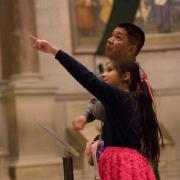
Designed by American architect John Russell Pope in the 1930s, the National Archives Building and especially its half-domed Rotunda offer an awe-inspiring setting in which to visit the U.S. founding documents. This program asks students to engage critically with the art and architecture of the National Archives Building and consider the ways in which the environment -- the building's neoclassical style, scale, imagery, and proximity to the National Mall -- frames their encounter. Students will consider the following questions: What do you think the architect wanted you to feel while standing in the Rotunda? What message did they want to share? How does this match what you know about the history of American democracy? At the end, students will be invited to imagine their very own artwork decorating the empty niches lining the Rotunda. How might they update the space to represent American society today?
America’s Freedom Train
Grades: 6-8 or 9-12 90 minutes
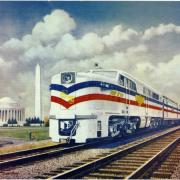
This program focuses on America's founding documents and their continuing role in shaping U.S. society. Inspired by the Freedom Train special exhibit dedicated to the history of American democracy that toured the United States in a seven-car train from September 1947 until January 1949, students will tour the National Archives Rotunda to view the Declaration of Independence, the Constitution, and the Bill of Rights and visit other highlights of the National Archives. Then, working in small groups, they will exercise civic literacy and historical analysis skills to justify which museum objects they would select for an updated Freedom Train exhibit marking the 250th anniversary of the Declaration of Independence. In what ways has the United States fulfilled the democratic ideals outlined in the founding documents? What could it have done better? How would you tell the story of American democracy today? How have ordinary Americans used the rights outlined in the Constitution to create a more perfect union?
Unveiling Stories: Power and Light: Russell Lee's Coal Survey
Grades: 3-8 90 minutes
This experience focuses on the temporary exhibit Power and Light: Russell Lee's Coal Survey , which features more than 200 of American documentary photographer Russell Lee’s photographs of coal miners and their families. Journeying into the gallery, students will engage in slow-looking to strengthen their observation and analytical skills while learning about the history and meaning of Lee's photographs. This program also asks students to make connections between photographs and story-telling. What stories are (and are not) present in Lee’s coal survey photographs?
Privacy notice
Why field trips matter, share this article.
- Facebook Icon: Facebook
- Twitter Logo: Twitter
- LinkedIn Logo: LinkedIn
- Email Icon: Email
A new study shows visiting an art museum improves critical thinking skills and more. An excerpt from “The Educational Value of Field Trips,” originally published in Education Next , Winter 2014.
This article originally appeared in the January/February 2014 issue of Museum magazine .
The school field trip has a long history in American public education. For decades, students have piled into yellow buses to visit a variety of cultural institutions, including art, natural history and science museums, as well as theaters, zoos, and historical sites. Schools gladly endured the expense and disruption of providing field trips because they saw these experiences as central to their educational mission: schools exist not only to provide economically useful skills in numeracy and literacy but also to produce civilized young men and women who would appreciate the arts and culture. More advantaged families may take their children to these cultural institutions outside of school hours, but less-advantaged students are less likely to have these experiences if schools do not provide them. With field trips, public schools viewed themselves as the great equalizer in terms of access to our cultural heritage.
Today, culturally enriching field trips are in decline. Museums across the country report a steep drop in school tours. For example, the Field Museum in Chicago at one time welcomed more than 300,000 students every year. Recently the number is below 200,000. Between 2002 and 2007, Cincinnati arts organizations saw a 30 percent decrease in student attendance. A survey by the American Association of School Administrators found that more than half of schools eliminated planned field trips in 2010-11.
The decision to reduce culturally enriching field trips reflects a variety of factors. Financial pressures force schools to make difficult decisions about how to allocate scarce resources, and field trips are increasingly seen as an unnecessary frill. Greater focus on raising student performance on math and reading standardized tests may also lead schools to cut field trips. Some schools believe that student time would be better spent in the classroom preparing for the exams. When schools do organize field trips, they are increasingly choosing to take students on trips to reward them for working hard to improve their test scores rather than to provide cultural enrichment. Schools take students to amusement parks, sporting events and movie theaters instead of to museums and historical sites.
If schools are de-emphasizing culturally enriching field trips, has anything been lost as a result? Surprisingly, we have relatively little rigorous evidence about how field trips affect students. The research presented here is the first large-scale randomized control trial designed to measure what students learn from school tours of an art museum.
We find that students learn quite a lot. In particular, enriching field trips contribute to the development of students into civilized young men and women who possess more knowledge about art, have stronger critical-thinking skills, exhibit increased historical empathy, display higher levels of tolerance, and have a greater taste for consuming art and culture.
Design of the Study and School Tours
The 2011 opening of the Crystal Bridges Museum of American Art in Northwest Arkansas created the opportunity for this study. Crystal Bridges is the first major art museum to be built in the United States in the last four decades, with more than 50,000 square feet of gallery space and an endowment in excess of $800 million. Portions of the museum’s endowment are devoted to covering all of the expenses associated with school tours. Crystal Bridges reimburses schools for the cost of buses, provides free admission and lunch, and even pays for the cost of substitute teachers to cover for teachers who accompany students on the tour.
Because the tour is completely free to schools, and because Crystal Bridges was built in an area that never previously had an art museum, there was high demand for school tours. Not all school groups could be accommodated right away. So our research team worked with the staff at Crystal Bridges to assign spots for school tours by lottery. During the first two semesters of the school tour program, the museum received 525 applications from school groups representing 38,347 students in kindergarten through grade 12. We created matched pairs among the applicant groups based on similarity in grade level and other demographic factors. An ideal and common matched pair would be adjacent grades in the same school. We then randomly ordered the matched pairs to determine scheduling prioritization. Within each pair, we randomly assigned which applicant would be in the treatment group and receive a tour that semester and which would be in the control group and have its tour deferred.
We administered surveys to 10,912 students and 489 teachers at 123 different schools for three weeks, on average, after the treatment group received its tour. The student surveys included multiple items assessing knowledge about art as well as measures of historical empathy, tolerance and sustained interest in visiting art museums.
We also assessed students’ critical thinking skills by asking them to write a short essay in response to a painting that they had not previously seen. Finally, we collected a behavioral measure of interest in art consumption by providing all students with a coded coupon good for free family admission to a special exhibit at the museum to see whether the field trip increased the likelihood of students making future visits.
The intervention we studied is a modest one. Students received a one-hour tour of the museum in which they typically viewed and discussed five paintings. Some students were free to roam the museum following their formal tour, but the entire experience usually involved less than half a day. The discussion of each painting during the tour was largely student-directed, with the museum educators facilitating the discourse and providing commentary beyond the names of the work and the artist and a brief description only when students requested it.
Recalling Tour Details. Our research suggests that students retain a great deal of factual information from their tours. Students who received a tour of the museum were able to recall details about the paintings they had seen at very high rates. For example, 88 percent of the students who saw the Eastman Johnson painting “At the Camp-Spinning Yams and Whittling” knew when surveyed weeks later that the painting depicts abolitionists making maple syrup to undermine the sugar industry, which relied on slave labor. Similarly, 82 percent of those who saw Norman Rockwell’s “Rosie the Riveter” could recall that the painting emphasizes the importance of women entering the workforce during World War II. Among students who saw Thomas Hart Benton’s “Ploughing It Under,” 79 percent recollected that it is a depiction of a farmer destroying his crops as part of a Depression-era price support program. And 70 percent of the students who saw Romare Bearden’s “Sacrifice” could remember that it is part of the Harlem Renaissance art movement. Since there was no guarantee that these facts would be raised in student-directed discussions, and because students had no particular reason for remembering these details (there was no test or grade associated with the tours), it is impressive that they could recall historical and sociological information at such high rates.
These results suggest that art could be an important tool for effectively conveying traditional academic content, but this analysis cannot prove it. The control-group performance was hardly better than chance in identifying factual information about these paintings, but they never had the opportunity to learn the material. The high rate of recall of factual information by students who toured the museum demonstrates that the tours made an impression. The students could remember important details about what they saw and discussed.
Critical Thinking. Beyond recalling the details of their tour, did a visit to an art museum have a significant effect on students? Our study demonstrates that it did. For example, students randomly assigned to receive a school tour of Crystal Bridges later displayed demonstrably stronger ability to think critically about art than the control group.
During the first semester of the study, we showed all 3rd- through 12th-grade students a painting they had not previously seen, Bo Bartlett’s “The Box.” We then asked students to write short essays in response to two questions: What do you think is going on in this painting? And, what do you see that makes you think that? These are standard prompts used by museum educators to spark discussion during school tours. We stripped the essays of all identifying information and had two coders rate the compositions using a seven-item rubric for measuring critical thinking that was developed by researchers at the Isabella Stewart Gardner Museum in Boston.
We express the impact of a school tour of Crystal Bridges on critical thinking skills in terms of standard deviation effect sizes. Overall, we find that students assigned by lottery to a tour of the museum improve their ability to think critically about art by 9 percent of a standard deviation relative to the control group. The benefit for disadvantaged groups is considerably larger.
A large amount of the gain in critical thinking skills stems from an increase in the number of observations that students made in their essays. Students who went on a tour became more observant, noticing and describing more details in an image. Being observant and paying attention to detail is an important and highly useful skill that students learn when they study and discuss works of art.
Historical Empathy. Tours of art museums also affect students’ values. Visiting an art museum exposes students to a diversity of ideas, peoples, places and time periods. That broadening experience imparts greater appreciation and understanding. We see the effects in significantly higher historical empathy and tolerance measures among students randomly assigned to a school tour of Crystal Bridges.
Historical empathy is the ability to understand and appreciate what life was like for people who lived in a different time and place. This is a central purpose of teaching history, as it provides students with a clearer perspective about their own time and place. To measure historical empathy, we included three statements on the survey with which students could express their level of agreement or disagreement: 1) I have a good understanding of how early Americans thought and felt; 2) I can imagine what life was like for people 100 years ago; and 3) When looking at a painting that shows people, I try to imagine what those people a thinking. We combined these items into a scale measuring historical empathy.
Students who went on a tour of Crystal Bridges experience a 6 percent of a standard deviation increase in historical empathy. Among rural students, the benefit is much larger, a 15 percent of a standard deviation gain. The fact that Crystal Bridges features art from different periods in American history may have helped produce these gains in historical empathy.
Tolerance. To measure tolerance, we included four statements on the survey with which students could express their level of agreement or disagreement: 1) People who disagree with my point of view bother me; 2) Artists whose work is critical of America should not be allowed to have their work shown in art museums; 3) I appreciate hearing views different from my own; and 4) I think people can have different opinions about the same thing. We combined these items into a scale measuring the general effect of the tour on tolerance.
Overall, receiving a school tour of an art museum increases student tolerance by 7 percent of a standard deviation. As with critical thinking, the benefits are much larger for students in disadvantaged groups. Rural students who visited Crystal Bridges experience a 13 percent of a standard deviation improvement in tolerance. For students at high-poverty schools, the benefit is 9 percent of a standard deviation.
Interest in Art Museums. Perhaps the most important outcome of a school tour is whether it cultivates an interest among students in returning to cultural institutions in the future. If visiting a museum helps improve critical thinking, historical empathy, tolerance and other outcomes not measured in this study, then those benefits would compound for students if they were more likely to frequent similar cultural institutions throughout their life. The direct effects of a single visit are necessarily modest and may not persist, but if school tours help students become regular museum visitors, they may enjoy a lifetime of enhanced critical thinking, tolerance and historical empathy.
We measured how school tours of Crystal Bridges develop in students an interest in visiting art museums in two ways: with survey items and a behavioral measure. Interest in visiting art museums among students who toured the museum is 8 percent of a standard deviation higher than that in the randomized control group. Among rural students, the increase is much larger: 22 percent of a standard deviation. Students at high-poverty schools score 11 percent of a standard deviation higher on the cultural consumer scale if they were randomly assigned to tour the museum. And minority students gain 10 percent of a standard deviation in their desire to be art consumers.
We also measured whether students are more likely to visit Crystal Bridges in the future if they received a school tour. All students who participated in the study during the first semester, including those who did not receive a tour, were provided with a coupon that gave them and their families free entry to a special exhibit at Crystal Bridges. The coupons were coded so that we could determine the applicant group to which students belonged. Students had as long as six months after receipt of the coupon to use it.
We collected all redeemed coupons and were able to calculate how many adults and youths were admitted. Though students in the treatment group received 49 percent of all coupons that were distributed, 58 percent of the people admitted to the special exhibit with those coupons came from the treatment group. In other words, the families of students who received a tour were 18 percent more likely to return to the museum than we would expect if their rate of coupon use was the same as their share of distributed coupons.
This is particularly impressive given that the treatment-group students had recently visited the museum. Their desire to visit a museum might have been satiated, while the control group might have been curious to visit Crystal Bridges for the first time. Despite having recently been to the museum, students who received a school tour came back at higher rates. Receiving a school tour cultivates a taste for visiting art museums, and perhaps for sharing the experience with others.
Disadvantaged Students
One consistent pattern in our results is that the benefits of a school tour are generally much larger for students from less-advantaged backgrounds. Students from rural areas and high-poverty schools, as well as minority students, typically show gains that are two to three times larger than those of the total sample. Disadvantaged students assigned by lottery to receive a school tour of an art museum make exceptionally large gains in critical thinking, historical empathy, tolerance and becoming art consumers.
It appears that the less prior exposure to culturally enriching experiences students have, the larger the benefit of receiving a school tour of a museum. We have some direct measures to support this explanation. To isolate the effect of the first time visiting the museum, we truncated our sample to include only control-group students who had never visited Crystal Bridges and treatment-group students who had visited for the first time during their tour. The effect for this first visit is roughly twice as large as that for the overall sample, just as it is for disadvantaged students.
When we examine effects for subgroups of advantaged students, we typically find much smaller or null effects. Students from large towns and low-poverty schools experience few significant gains from their school tour of an art museum. If schools do not provide culturally enriching experiences for these students, their families are likely to have the inclination and ability to provide those experiences on their own. But the families of disadvantaged students are less likely to substitute their own efforts when schools do not offer culturally enriching experiences. Disadvantaged students need their schools to take them on enriching field trips if they are likely to have these experiences at all.
Policy Implications
School field trips to cultural institutions have notable benefits. Students randomly assigned to receive a school tour of an art museum experience improvements in their knowledge of and ability to think critically about art, display stronger historical empathy, develop higher tolerance, and are more likely to visit such cultural institutions as art museums in the future. If schools cut field trips or switch to “reward” trips that visit less-enriching destinations, then these important educational opportunities are lost. It is particularly important that schools serving disadvantaged students provide culturally enriching held trip experiences.
This first-ever, large-scale, random-assignment experiment of the effects of school tours of an art museum should help inform the thinking of school administrators, educators, policymakers and philanthropists. Policymakers should consider these results when deciding whether schools have sufficient resources and appropriate policy guidance to take their students on tours of cultural institutions. School administrators should give thought to these results when deciding whether to use their resources and time for these tours. And philanthropists should weigh these results when deciding whether to build and maintain these cultural institutions with quality educational programs. We don’t just want our children to acquire work skills from their education; we also want them to develop into civilized people Students tour the galleries at the Crystal Bridges Museum of American Art. who appreciate the breadth of human accomplishments. The school field trip is an important tool for meeting this goal.
Jay P. Greene is professor of education reform at the University of Arkansas, Fayetteville, where Brian Kisida is a senior research associate. Daniel H. Bowen is a postdoctoral fellow at Rice University’s Ki nder Institute, Houston, Texas. Anne Kraybill, school and community programs manager at Crystal Bridges Museum of American Art, oversaw the development and implementation of the school tours. To read the full report, go to http // educationnext.org/the-educational-value·of- field-trips/
AAM Member-Only Content
AAM Members get exclusive access to premium digital content including:
- Featured articles from Museum magazine
- Access to more than 1,500 resource listings from the Resource Center
- Tools, reports, and templates for equipping your work in museums
- Not a member? Join Now
- Learn more about AAM Membership
We're Sorry
Your current membership level does not allow you to access this content.
- Learn More about AAM Membership
Upcoming Events

Safeguarding Collections

Old Collection, New Pride: Fresh Takes to Diversify Programming

The Accessible Museum: How to create an accessible experience for guests who are blind or low vision – FREE OMA Webinar
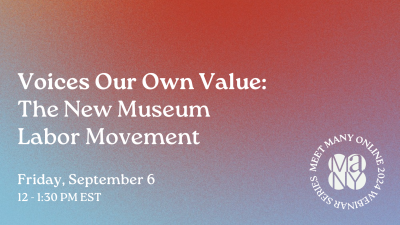
Voicing Our Own Value: The New Museum Labor Movement
Leave a reply cancel reply.
Your email address will not be published. Required fields are marked *
Latest Stories from AAM
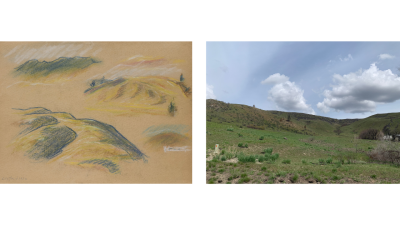
Reviving Roots: Clyfford Still Museum and the Colville Confederated Tribes Partner for the Future
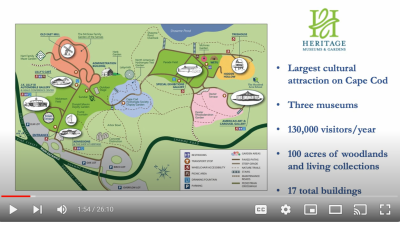
Reducing Carbon Emissions in a Complex Environment
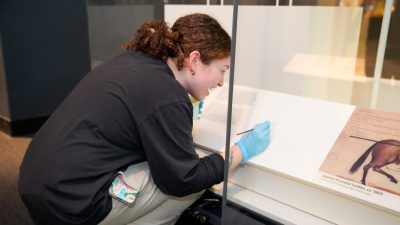
Museum Apprenticeships as Entry Points for Future Leaders
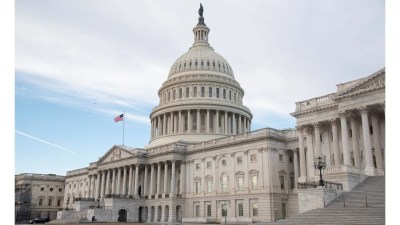
August Appropriations Update: Keep Speaking Up for Museums
Subscribe to field notes.
Packed with stories and insights for museum people, Field Notes is delivered to your inbox every Monday. Once you've completed the form below, confirm your subscription in the email sent to you.
If you are a current AAM member, please sign-up using the email address associated with your account.
Primary Role Archivist/Librarian Board Chair (unpaid) Community Outreach/External Relations Conservation Consultant/Independent Professional Curatorial Development Educator: College/University Educator: Museum Exhibitions Facility/Operations Finance & Accounting Former Director/CEO General Administrative Staff Government Agency Staff Government Relations HR IT/Web Legal Living Collections Care Membership Museum Events/Food Service Museum Store Museum Trustee Museum Volunteer Other Museum Function Other Non-Museum Function President/CEO/Executive Director Public Relations & Marketing Publications Registration/Collections Management Research: Audience Evaluation Research: Discipline Based Retired Museum Staff Security Senior Management/VP/COO/CFO/Division Director Student: Museum-Related Student: Other Visitor Services Volunteer Management
Are you a museum professional? Yes No
Are you a current AAM member? Yes No
Success! Now check your email to confirm your subscription, and please add [email protected] to your safe sender list.

- Outreach Performances & Programs
- Fundraising
- Field trip lesson plans
- Field Trips Grants
- Service Learning
- Hot Springs
- Little Rock
- Los Angeles
- San Francisco
- Colorado Springs
- Statewide / Region
- Daytona Beach
- Fort Lauderdale
- Gainesville
- Jacksonville
- Orlando-Metro
- Palm Beach Metro
- Space Coast
- Tallahassee
- St. Augustine
- St Petersburg-Clearwater
- Atlanta-Metro
- Chicago-Metro
- Springfield
- Central Region
- Indianapolis
- North Region
- South Region
- Bowling Green
- Baton Rouge
- New Orleans
- Baltimore-Metro
- The Berkshires
- Boston-Metro
- Cape Cod/Plymouth
- Greater Lowell
- Greater Springfield
- Grand Rapids
- Capital-River Region
- Delta Region
- Gulf Coast Region
- Hills Region
- Pines Region
- Jefferson City
- Kansas City
- Springfield-MO
- Delaware River Region
- Gateway Region NJ
- Greater Atlantic City
- Shore Region
- Skylands Region
- Southern Shore Region
- Capital District Region
- Central New York Region
- Finger Lakes Region
- Hudson Valley Region
- Long Island
- Mohawk Valley Region
- New York City
- North Country Region
- Southern Tier Region
- Western New York Region
- Cincinnati Ohio
- Cleveland Ohio
- Columbus Ohio
- Metro Canton Ohio
- Oklahoma City
- Allegheny Mts. & Valleys
- Gettysburg/York
- Harrisburg-Metro
- Lakes & Erie Regions
- Lancaster-Metro
- Lehigh Valley
- Philadelphia Metro
- Pittsburgh & Laurel Highlands
- The Poconos
- Scranton/Wilkes-Barre
- Chattanooga
- East Tennessee
- Middle Tennessee
- The Smokies
- West Tennessee
- Bryan - College Station
- Corpus Christi
- Dallas/Fort Worth
- Panhandle Plains Region
- San Antonio
- Central Virginia
- Chesapeake Bay Region
- Coastal Virginia -Eastern Shore
- Coastal Virginia-Hampton Roads
- Northern Virginia
- Shenandoah Valley
- Southern Virginia
- Southwest Virginia-Blue Ridge Highlands
- Southwest Virginia-Heart of the Appalachia
- Virginia Mountains
- Martinsburg
- Madison Wisconsin
Children’s Museum Lesson Plan
Please note, this lesson plan was created by FieldTripDirectory.com as a general guide and is not specific to any particular venue listed on our site.
Children’s museums feature interactive exhibits that are designed to be manipulated by children.
The first children’s museum in the world was the Brooklyn Children’s Museum, founded in 1899. Hundreds of children’s museums have opened in the United States since then. As of 2007, the Association of Children’s Museums estimated that there were approximately 80 children’s museums in development alone.
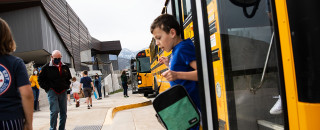
Request a Self-Guided Field Trip
Requests for the 2024-2025 school year are now OPEN!
Thank you for your interest in a field trip to NHMU! Use the calendar below to request a Self-Guided Field Trip. Interested in a different program? Find links to other program requests below.
Summer Field Trips
Junior Science Academy
Stay Curious, Utah!
Before booking a field trip:
- Submitting a request does not guarantee a reservation.
- Requests should be submitted at least 10 business days prior to your desired visit date.
- Watch for your confirmation email or contact from field trip staff. Due to high demand confirmation emails may take up to 2-3 weeks. We appreciate your patience.
- Lunch space is limited to 88 people total (includes students, chaperones, and teachers). Request a lunch reservation via the calendar below. No lunch space available? Find a picnic area near NHMU! Click here for nearby suggestions.
- Click here for Field Trip pricing information.
- Looking for all field trip information in one place? Our Field Trip Guide has all information for planning your visit!
Already have a field trip scheduled? Click here for the Steps to Field Trip Success to help prepare for your upcoming field trip.
To Use Field Trip Availability Calendar:
- Check or uncheck the colored boxes at the top to toggle a calendar type on or off.
- Occurrences on the calendar indicate that we still have some availability on that date. If you don't see an occurrence on the date you are interested in, there is no more availability on that date.
- If not all events are showing on a date, click the "+ more" button.
- Cl ick here for a detailed guide on the request proces s.
Questions? Contact us!
Requests for the 2024-25 school year are now OPEN!
- Support MIM
MIM Field Trips Help Students Connect with Cultural Heritage
August 14, 2024
Celebrations: Latin America tour is popular with school and youth groups

MIM’s field trips take young guests on journeys around the world through music, offering participants exciting opportunities to connect with their heritage. In Arizona, many young people have roots in Latin America, and MIM’s newest field trip, Celebrations: Latin America, has quickly become popular with Phoenix-area school and youth groups.
Celebrations: Latin America focuses on festivals and visits the Brazil, Puerto Rico, and Mexico exhibits, among others. The field trip is designed for learners ages 5–8 and includes hands-on drumming or musical story time in addition to gallery exploration with a museum guide.
“Our children connected with their ancestral heritage,” says a kindergarten and 1 st grade teacher from the Pendergast Elementary School District whose class took a Celebrations: Latin America tour this year.

A drawing included in a thank-you note to MIM shows a 4 th grade student’s favorite part of their field trip: playing a Little Martin guitar in the Experience Gallery.
“They came away from MIM with a sense of wonder, of how they, too, can learn to play musical instruments.”
During the tour, participants also watch a video of a Bolivian musician playing the charango —a small, guitar-like instrument emblematic of the Andes—and learn how performers at Peruvian festivals cooperatively share the melody of a song between different sets of siku panpipes. Many students are amazed at the athleticism of Peru’s scissors dancers and appreciate the ornate decorations of the bumba-meu-boi ox costume in the Brazil exhibit and the vejigante Carnival mask in the Puerto Rico exhibit.
“My students were . . . able to immerse themselves in understanding their musical roots,” says a 2 nd grade teacher from the Alhambra Elementary School District, who was also pleased that students learned about instruments from many different cultures.
Students love the free-choice learning portion of the field trip, when they use MIM’s Sennheiser guidePORT headsets to experience exhibits in the Geographic Galleries at their own pace. At the end of a recent Celebrations: Latin America tour, one child remarked that listening to the different types of music was their favorite part of the trip.
“The students expressed that it was the best day ever,” says another 2 nd grade teacher from the Alhambra Elementary School District. “They also shared that they wanted to bring their families to the museum.”
Learn more about MIM’s field trips.

You are using an outdated browser. Please upgrade your browser to improve your experience.

The Museum to Close through 2024 for Construction
Starting July 22nd, the Museum will be closed to prepare for Thor and other exciting changes.
Dimensions in Testimony℠ from USC Shoah Foundation
Dimensions in Testimony℠ from USC Shoah Foundation combines ultra-high-definition filming and natural language technology to allow a conversational and interactive experience between Holocaust Survivors and audiences. The FHM is among only a dozen museums in the world to house this unique exhibition. Dimensions in Testimony℠ was developed in association with Illinois Holocaust Museum and Education Center, with technology by USC Institute for Creative Technologies, and concept by Conscience Display. Funding for Dimensions in Testimony was provided in part by Pears Foundation, Louis. F. Smith, Melinda Goldrich and Andrea Cayton/Goldrich Family Foundation in honor of Jona Goldrich, Illinois Holocaust Museum and Education Center, and Genesis Philanthropy Group (R.A.). Other partners include CANDLES Holocaust Museum and Education Center.
- Visit the Museum
The Museum is closed through early 2025 for renovations.
Purchase your timed-entry tickets in advance.
55 Fifth Street South St. Petersburg, FL 33701
Find out what is currently on view and plan your visit to the Museum.
The Florida Holocaust Museum, a service provider contracted by the Florida Department of Education, invites you to use our dynamic lessons and curriculums about the Holocaust, genocide, and character education.
We depend on the generosity of our donors who share our vision. With their support, we can continue our mission of education. Please consider becoming a donor, there are many different way to give.
Search the Permanent Collection
The Museum’s collections are made up of materials donated to us by survivors, liberators, and their families and document their experiences during the Holocaust. Search the collection to find out more.
WE SHARE THE SAME SKY The Retelling of Family History Becomes the History Itself
We Share The Same Sky is an exhibition that tells the story of Holocaust survivor Hana Dubová and her granddaughter, Rachael Cerrotti, who spent more than a decade retracing her grandmother’s wartime history. You will meet people of the past and present who show us how the retelling of family history becomes history itself. The exhibition is told in Rachael’s and the included correspondence, photographs, and other media were documented by her or found in her grandmother’s archive. This exhibition aims to encourage all of us to be curious about where we come from and why it matters. Hana asks what her story means to the next generation and Rachael does her best to find out.
Babyn Yar and the Art of Felix Lembersky
Yelena Lembersky will speak about her grandfather’s paintings, his journey from Poland and Ukraine to Russia, and his life of resistance to the erasure of Jewish memory. She will also talk about her critically-acclaimed memoir, Like a Drop of Ink in a Downpour, growing up as a child-refusenik, while her mother and grandmother took on the mission and tremendous risks to save this timeless art.
- Purchase Tickets
- Museum FAQs
- Tours & Rentals
- Menu Column 2
- Book a Field Trip
- Holocaust Education Week
- Teaching Trunks
- Teacher Training
- Virtual Library
- Speakers’ Bureau
- Virtual Learning Resources
- Testimony Videos
- Middle School Outreach
- Law Enforcement and Society
- Museum Guide for Educators
- On Demand Education
- Ways to Give
- Life Members
- Tributes & Memorial Gifts
- Planned Giving
- Donate to the Collection
- Generations After
- Annual Support
- Virtual Exhibitions
- Permanent Exhibitions
- Special Exhibitions
- Dimensions in Testimony℠
- Upcoming Exhibitions
- Traveling Exhibitions
- Past Exhibitions
- Featured Collections
- History, Heritage & Hope
- Search the Collection
- Survivor Testimonies
- Shoah Victims’ Names Recovery Project
- Events Calendar
- To Life Annual Benefit
- Anne Frank Humanitarian Award
- Mission, Vision & History
- Museum Departments
- Our Mission
- Buy Tickets
- Become a Member
Help Us Ignite the Future Today!

Thanks to the generosity of Amy and Michael Southard and their foundation, Crofton Cares, donations made to the Ignite the Future: Teaching Trunks of Hope project between August 14 and September 13 will be matched up to $30,000.
Robot Fighter Pilot
Artificial intelligence proves it can dogfight. What’s next?
Science fiction took another leap toward becoming science fact this past spring, when an aircraft piloted by artificial intelligence (AI) engaged in a dogfight against a human-piloted F-16.
“The potential for autonomous air-to-air combat has been imaginable for decades, but the reality has remained a distant dream up until now,” said Secretary of the Air Force Frank Kendall. “This is a transformational moment.”
The unprecedented achievement is the result of a collaboration between the U.S. Air Force and the Defense Advanced Research Projects Agency (DARPA) that has, over the decades, overseen the development of transformative technologies such as the computer mouse, GPS, and even the internet itself. DARPA’s Air Combat Evolution program pitted an X-62A Variable In-Flight Simulator Test Aircraft (VISTA) against an F-16 to begin evaluating autonomous AI systems that could move beyond computer simulations and soar into the air. The scenario harks back to when earlier generations of programmers taught computers to play chess—except now the chess pieces are $60 million aircraft flying at one another at 1,200 mph. The objective of the AI flight exercise wasn’t to explicitly create a robot fighter pilot. Rather, programmers see air-to-air combat as a highly complex problem for an artificial intelligence to solve, pushing machine learning to new limits. The AI team made over 100,000 lines of flight-critical software changes across 21 test flights that began last September, culminating with the successful air-to-air combat demonstration in mid-April. The aerial battle began with defensive maneuvers before switching to offensive nose-to-nose engagements.
The Air Force is planning for an AI-enabled fleet of more than 1,000 unpiloted warplanes, the first of them operating by 2028. But officials stress that there will always be human oversight when weapons are involved. During tests, for example, the X-62A is flown with onboard safety pilots, who have the ability to disengage the AI.

NASA’s Chandra X-Ray Observatory was deployed by space shuttle Columbia on July 23, 1999.
An Astronomically Important Shuttle Mission
Twenty-five years ago this summer, space shuttle Columbia lifted off and made history. STS-93 was the first shuttle mission commanded by a woman (Eileen Collins), and it carried some very special cargo: the Chandra X-ray Observatory. One of NASA’s “Great Observatories,” Chandra is the world’s most powerful X-ray telescope. It detects X-ray emissions from extremely hot regions in the universe. Chandra’s “first light” image was released August 26, 1999—a view of supernova remnant Cassiopeia A. In the 25 years since, Chandra has made countless discoveries. Today, the telescope is operated by the Center for Astrophysics | Harvard & Smithsonian.

Over the past 25 years, Chandra has captured arresting images of the universe, including spiral galaxies, supernovae, and massive gas clouds.
The National Air and Space Museum will celebrate the 25th anniversary of the Chandra X-ray Observatory during its annual John H. Glenn Lecture in Space History on September 25 at 8 pm ET. The event will take place at the Steven F. Udvar-Hazy Center in Chantilly, Virginia, and will be streamed live online.
STS-93 commander Eileen Collins and mission specialist Cady Coleman will reflect on the mission that deployed the observatory. They will be joined by two scientists working with Chandra data today. Patrick Slane, director of the Smithsonian Astrophysical Observatory’s Chandra X-ray Center, and Kimberly Arcand, visualization scientist and emerging technology lead for the Chandra X-ray Observatory, will discuss the science of Chandra and share some of the most exciting discoveries from its 25 years in orbit. Learn more and register to attend.

Baked in Space
This is no ordinary cookie. This cookie was baked aboard the International Space Station during Expedition 61 in late 2019. Comfort foods and fun activities can make long stays easier to endure—and what better way to do that than baking cookies? Astronauts experimented with baking times and temperatures using a space-friendly oven designed by Zero G Kitchen, DoubleTree by Hilton, and Nanoracks. This was the fifth of five cookies. It was baked at 325°F for 130 minutes and was regarded as the best of the batch. Museum visitors can see the cookie on display at the Steven F. Udvar-Hazy Center in Chantilly, Virginia.
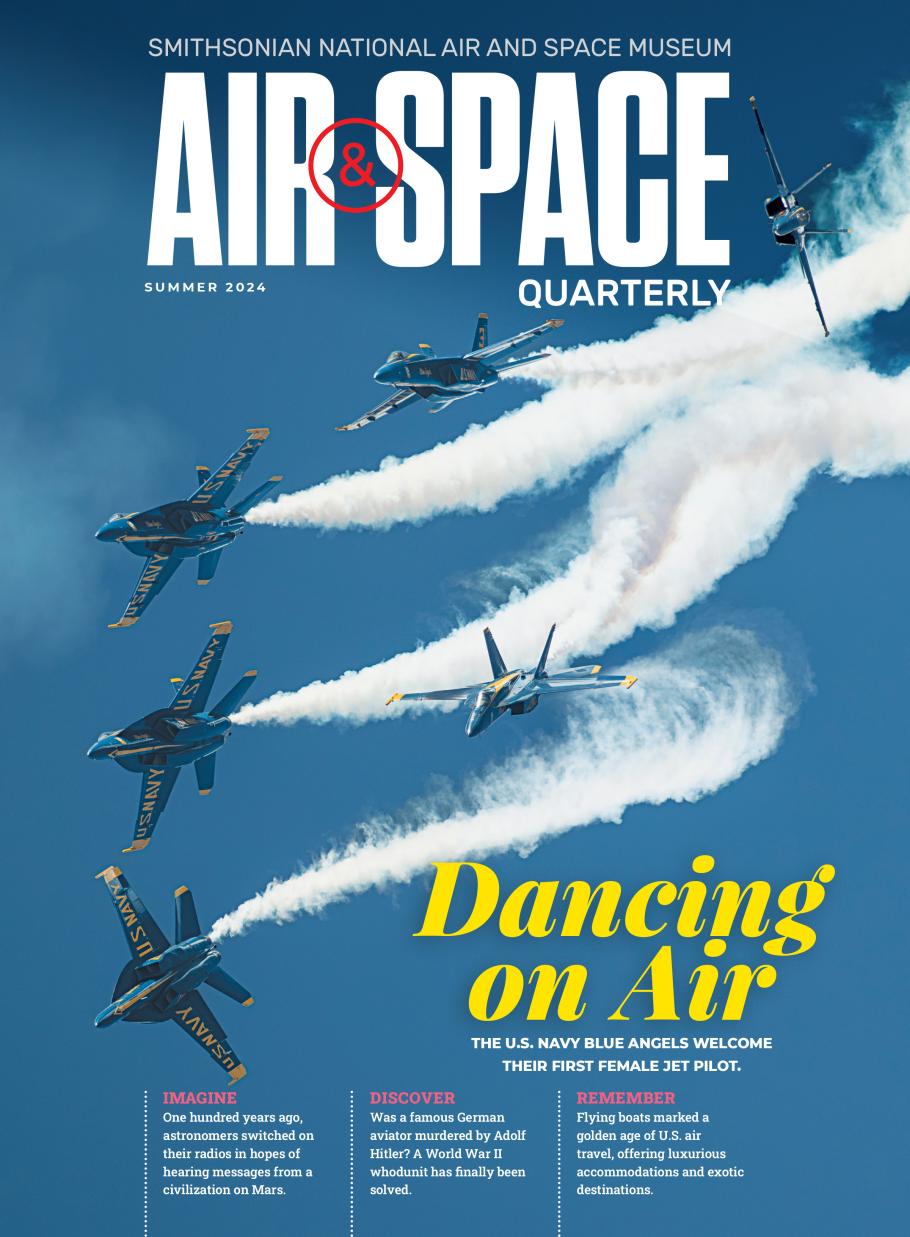
This article is from the Summer 2024 issue of Air & Space Quarterly , the National Air and Space Museum's signature magazine that explores topics in aviation and space, from the earliest moments of flight to today. Explore the full issue.
Want to receive ad-free hard-copies of Air & Space Quarterly ? Join the Museum's National Air and Space Society to subscribe.
We rely on the generous support of donors, sponsors, members, and other benefactors to share the history and impact of aviation and spaceflight, educate the public, and inspire future generations. With your help, we can continue to preserve and safeguard the world’s most comprehensive collection of artifacts representing the great achievements of flight and space exploration.
- Get Involved
- Host an Event
Thank you. You have successfully signed up for our newsletter.
Error message, sorry, there was a problem. please ensure your details are valid and try again..
- Free Timed-Entry Passes Required
- Terms of Use
Learning Charlotte Pride history with Levine Museum of the New South

CHARLOTTE, N.C. (QC Life) - The Levine Museum of the New South has partnered with Charlotte Pride to share all things history this weekend.
Charlotte Pride is just days away. The Levine Museum of the New South is ready with a museum exhibit, and will also be present at the festival.
Learn more about the museum’s Pride involvement in the video player above.
About Charlotte Pride
The Charlotte Pride festival will run from noon-11 p.m. on Saturday, and from noon-6 p.m. on Sunday. The Charlotte Pride parade is scheduled for 1 p.m.-4 p.m. on Sunday.
The Pride “festival zone” is located on South Tryon Street. The parade will take place on North Tryon Street.
Traffic is expected to be worse than normal due to the event. View our real-time traffic map here.
Visit the official Charlotte Pride website here for more information about the event.
Copyright 2024 WBTV. All rights reserved.

Sheriff: Suspect arrested after Salisbury store owner shot, killed

School district cancels field trips because of low test scores

Cause of death released after 8-year-old girl dies on flight while vacationing with family

Police: Juvenile killed in south Charlotte homicide

Belmont Central Elementary students return to class after gas leak prompts evacuation

Vehicles identified in Charlotte Airport fire

Beloved Rock Hill baseball coach killed in crash while driving to game

Troopers: Man killed in two-vehicle Caldwell County crash

School District Cancels All Future Field Trips For Odd Reason, Parents Are Furious
W ho doesn’t remember the most fun and exciting part of school growing up: the field trips. It didn’t matter if you were going to see the inner workings of a sewage plant or a museum, you knew you were going to leave school property, and that was epic.
But, one school district in Tennessee has canceled all field trips due to low test scores in reading and math, according to a local news source.
This all happened in a small county near Memphis. Fayette County Public Schools made an announcement, apparently on social media, that all field trips have indeed been canceled.
Parents that found out about it were not happy, in the least.
Apparently, the school board here thinks that taking away off-campus learning excursions is the way to increase test scores amongst its students.
According to WREG TV , Ashley Turner has children in Fayette County Schools and says the change is not cool.
“They go a few different places,” Turner said. “Most of the time educational, and I feel like they’re learning more from the field trips because they’re having fun.”
The school district in this small Tennessee county feels as if the kids should focus on their math and reading rather than taking time to go off-campus to learn something intriguing.
Turner also pushed back saying that she believes the reason for low test scores has more to do with a lack of teachers.
“They don’t have teachers to teach the kids, so how are they going to have higher test scores when half of them… they went a whole year last year without a math teacher,” Turner claimed.
Onto the other side of it is the places where kids go on their field trips. Bart Gilmer and his family own an educational working farm in the area, which usually sees a lot of school classes come through for field trips.
Gilmer was asked what he thought about the canceling of all future field trips due to low test scores, and he did not have anything good to say about it either.
“Personally I think it’s a bad decision,” he shared.
Gilmer goes on to explain his comment, “On a good year we’ll have 6,000-7,000 kids come out here and experience life on the farm and get to see some stuff that they may have never seen before and may never get to see again.”
Gilmer also acknowledged that his business would suffer.
“We would certainly take a hit,” he said. “I don’t see where taking the field trips away from them is going to help test scores at the end of the day.”
Taking this opportunity away from these kids is Fayette Country School’s answer to low test scores. Only time will tell if the odd idea indeed works.
Evan Paul is the host of Taste of Country Nights , a syndicated radio show heard on more than 130 country radio stations nationwide, every night from 7PM to midnight. He plays the best new country music and interviews today’s top stars, like Luke Combs, Morgan Wallen, Kenny Chesney, Miranda Lambert, Dan + Shay, Keith Urban, Carrie Underwood, Luke Bryan, Chris Stapleton, Lady A, + more!

- Quick Facts
- Sights & Attractions
- Tsarskoe Selo
- Oranienbaum
- Foreign St. Petersburg
- Restaurants & Bars
- Accommodation Guide
- St. Petersburg Hotels
- Serviced Apartments
- Bed and Breakfasts
- Private & Group Transfers
- Airport Transfers
- Concierge Service
- Russian Visa Guide
- Request Visa Support
- Walking Tours
- River Entertainment
- Public Transportation
- Travel Cards
- Essential Shopping Selection
- Business Directory
- Photo Gallery
- Video Gallery
- 360° Panoramas
- Moscow Hotels
- Moscow.Info
- Imperial Estates
- Oranienbaum (Lomonosov)
Grand Menshikov Palace
Menshikov began to build his residence here in 1713, at about the same time as Peter began work on his own estate at Peterhof. Menshikov seemed intent on outdoing his master in terms of scale and grandeur, and commissioned architects Giovanni Mario Fontana and Gottfried Schadel, who were already building the Menshikov Palace in St. Petersburg, to design his seaside palace. After over a decade of work, which eventually bankrupted Menshikov, the palace was completed.
Facing the sea, with a two-level terrace in front of it, this charming yellow and white building consists of a concave central block with two single-storey galleries leading to prominent octagonal pavilions, one of which houses the palace chapel. On the south side of the building, two large ancillary wings, the Kitchen Wing and the Ladies' Wing, run from the pavilions perpendicular to the central block.
Menshikov had little time to enjoy his new palace before he was arrested and exiled in 1727. The estate at Oranienbaum was passed to the state, and Menshikov's palace became a naval hospital. In 1743, the estate was presented by Empress Elizabeth to her nephew, the future Peter III, who commissioned Francesco Bartolomeo Rastrelli, the greatest late baroque architect working in Russia, to renovate the palace. Rastrelli left the exterior of the palace almost untouched, but created sumptuous interiors that have, sadly, long since been destroyed. At this time, the western pavilion became known as the Japanese Pavilion, thanks to the collection of Japanese and Chinese ceramics it housed.
The palace was altered again in 1762 by Antonio Rinaldi, who added a granite staircase and semi-circular balcony to the northern terraces and redecorated many of the interiors. After serving as a Naval Cadet College from the end of the 18 th century, the palace was used as a residence by both Alexander I and his brother Mikhail. During the 19 th century, several famous architects, including Luigi Ruska, Carlo Rossi, and Vasiliy Satsov, reworked the interiors of the palace.
Today, while the Grand Menshikov Palace is still extremely impressive from the outside, its interiors are in a parlous state, and major renovation work still needs to be done to prevent parts of the building collapsing. For visitors, there is little to see except a collection of portraits of the various owners of Oranienbaum.
We can help you make the right choice from hundreds of St. Petersburg hotels and hostels.
Live like a local in self-catering apartments at convenient locations in St. Petersburg.
Comprehensive solutions for those who relocate to St. Petersburg to live, work or study.
Maximize your time in St. Petersburg with tours expertly tailored to your interests.
Get around in comfort with a chauffeured car or van to suit your budget and requirements.
Book a comfortable, well-maintained bus or a van with professional driver for your group.
Navigate St. Petersburg’s dining scene and find restaurants to remember.
Need tickets for the Mariinsky, the Hermitage, a football game or any event? We can help.
Get our help and advice choosing services and options to plan a prefect train journey.
Let our meeting and events experts help you organize a superb event in St. Petersburg.
We can find you a suitable interpreter for your negotiations, research or other needs.
Get translations for all purposes from recommended professional translators.
- SI SWIMSUIT
- SI SPORTSBOOK
Two Point’s next game takes players on a trip to the museum
Oliver brandt | 11 hours ago.
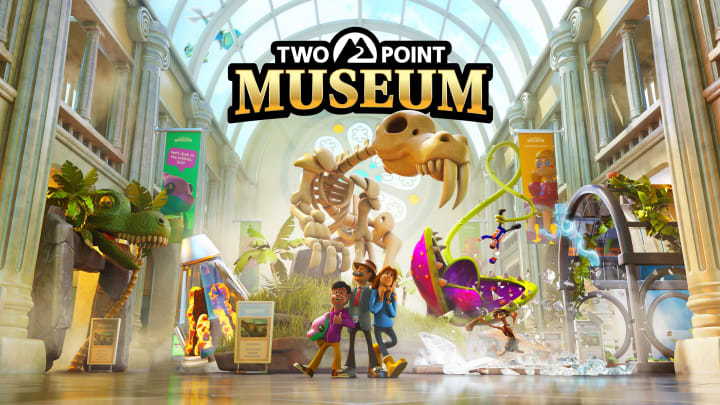
After the wildly successful (and wildly fun) Two Point Hospital and its follow-up Two Point Campus, the developer of the Theme Hospital spiritual successors has finally revealed the third game in its wacky series. It’s called Two Point Museum, and as you’d probably expect from the name, it will have players creating and managing a museum.
Two Point Museum was announced on the Two Point Studios website and on its socials with a trailer, which is packed with the charm and humor we’ve come to expect from the series. In the trailer, we see some elaborate museums, with dinosaur skeletons, science exhibits, an ancient computer, and more.
In a press release following the trailer’s release, publisher Sega revealed even more information about the game. In Two Point Museum, players will use the brand-new world map to venture to undiscovered areas and bring back relics of various kinds and rarities to decorate their museums.
GLHF was able to go hands-on with Two Point Museum, and found that it both iterates and innovates on the unique management-sim series .
“[Two Point Studios has] created a set of robust systems that bring out the joy of discovery, education, and design that comes with exploring the weird and wonderful corners of our world,” we said in our preview.
Like other games in the Two Point series, you’ll control the layout of the museum, hire staff, keep the place safe, and make sure you make a healthy profit in the process. Sega says there will be deeper customization options than ever before, and there’ll even be a gift shop, guided displays, and the ability to highlight exhibits.
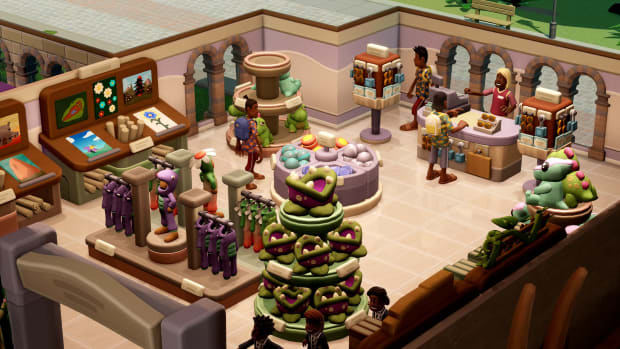
Of course, a museum is a place that is often filled with children, and you’ll be in charge of keeping those kids off the displays too, lest they get hurt or, even worse, damage the precious relics. You’ll also need to guard your museum well with security cameras and guards, to make sure there aren’t any heist situations happening.
No release date has been set for Two Point Museum yet, but Sega promises more information about the release will be coming “soon.” We do know, at least, that the game will be released on PC , PS5 , and Xbox Series X|S , which unfortunately means that last-gen consoles and the Nintendo Switch will be left behind. That’s a bummer, but have you seen the size of those dinosaur skeletons? There’s no way you’d be able to fit that into a Nintendo Switch, it’s just too big.

OLIVER BRANDT
Oliver Brandt is a writer based in Tasmania, Australia. A marketing and journalism graduate, they have a love for puzzle games, JRPGs, Yu-Gi-Oh!, and any platformer with a double jump.
Follow chocobalt
Two Point Museum turns a fresh slice of mundane life into a wacky British adventure
Funny bones.
What impressed me most about Two Point Studios' previous games was how far they flourished from a single concept. The simple seed of a hospital setting, and then a campus, were able to offer such a depth of systems, such a variety of gameplay - and of course a whole load of gags.
That's just as true with the newly-announced Two Point Museum, where, as the title implies, players are tasked with creating and managing a museum of historical exhibits. But, this being a Two Point game, things aren't as simple as they may first seem. Think Night At The Museum, but with zany and sarcastic British humour.
Designing a museum, decorating exhibits, adding gifts shops full of tat, providing restaurants, and seeking donations. All the obvious boxes have been ticked, but these alone would be mundane. Because of course, here in the world of Two Point County, exhibits aren't just a handful of bones but opportunities for discovery, as well as potential disaster.

Yet with all the possibilities of sim management games set in the wacky fictional world of Two Point County, why settle on a museum?
"We've got a list of lots of different ideas we consider for future games," design director Ben Huskins tells me as I sat down to play a brief demo of Two Point Museum. "The thing that really got us excited about Museum when we first started talking about it was this idea of building up these collections of these amazing artefacts... How do I get these amazing things to find and display in my museum? That immediately sparked lots of ideas with us."
"All the exhibits are really meaningful and have lots of gameplay integrated, which gave us quite a lot of flexibility," adds executive producer Jo Koehler. "We're seeing more than the previous games where people are building up their museums, they look genuinely unique because as soon as we got past the gameplay, we really pushed into the how do we get these museums feeling and looking amazing and incredible?"
Two Point Museum begins with the basics of item placement and decoration, as well as staff hires, but soon branches out. Firstly, creation is no longer restricted by rooms as in previous games. Now, partition walls can be used to provide structure and creation is far more free-form than before, with new floor and wall options, archways, decorative items, and visuals that focus on lighting each space.

Moreover, Two Point is branching further outside with expeditions. Exhibits aren't simply bought from a menu like hospital or school equipment would be; instead they must be excavated on trips across a gradually-unveiled world map and brought back to each museum's helipad. Experts are hired not only to keep exhibits in top shape, but to fly off on adventure at players' request and bring back new, exciting objects to display. A giant crate bobs and pops open to reveal your latest prize - it's like a fossil gacha machine.
Of course, this could bring disaster as much as joy. One expert came back from a trip with an illness and trod muddy footprints across the pristine floors of my museum. Two Point hinted even more tragic events could occur. Experts may even perish while away.
Expeditions are a key way the studio is advancing gameplay over previous games, with exploration and discovery not usually seen in the sim genre. It adds an extra layer of adventure and storytelling but also strategy, Huskins explains, as players will need to choose wisely which experts to send on expeditions and which to remain in the museum.
This demo focused solely on the prehistoric exhibits (the "starter pack," says Huskins), which required expeditions to the Bone Belt for excavation. Still, even these exhibits may not be what you expect. Yes there are dinosaurs - the likes of the Sharpontops and the Tugowaurus - but also a caveman preserved in ice who threatens to come alive, a fossilised future adventurer (thanks to time travel, naturally), and a giant, stone prehistoric computer. There's even a fossilised floppy disc, because our childhood is museum-worthy nowadays. Dinosaurs, in particular, are collected in parts with multiple fossils required to complete the set. It's a bit like Animal Crossing, as is the collection where players can complete the full suite of items from each exhibit set. I doubt the cafe has a pigeon serving customers, though.
What other themes are on the way? Two Point is naturally keeping tight-lipped, although I did spot some aquarium facilities in the game's trailer.

"We have some stuff that is grounded in reality," says Huskins, "so we obviously look at what are the sorts of things people would expect to see in a museum, because we always want that grounding. But then we have those slightly more out-there things that make sense in the world of Two Point County."
He points to previous games and lore implications for hints of what may be yet to come. "It's about getting that variety, both in terms of what these cool exhibits look like but also how they behave and how the player interacts with them."
Personally, I'm hoping for an art gallery where you're tasked with preventing soup-throwing vandals and heists. "Stay tuned," Huskins hints.
Two Point Museum has something far more frightening than dinosaurs though: children. Visitors will arrive in groups, including pesky kids who will run riot without proper entertainment. I noticed one climbing all over one of my precious fossils but was sadly unable to swat it away. Later, the game will introduce school trips and players will be able to plan tours to highlight their most precious possessions.
The inclusion of children is another way the studio is developing the genre, along with other new visitor types. Key to their "edutainment" is the workshop, which will allow players to create interactive displays, be that a dinosaur climbing frame or similar, and prevent them causing a nuisance. School trips will also be added in.
A big aim in the game, of course, is to generate cash. Each exhibit is given a Buzz score depending on how exciting and how well decorated it is; this in turn generates amazement from visitors, who are then more likely to donate at a nearby cash box stand. Just make sure there are enough security guards to prevent anything being stolen.
But the game is also about education, explains Huskins, in that players know a certain amount about exhibits and artefacts, but not everything. "Some of them are a bit more mysterious when you first find them," he says, "so there's this side of the game about how you as a museum manager are trying to find out more about these exhibits. Later, you're able to analyse your exhibits which then improves knowledge of them, which means you can write more about them on information stands, and then guests learn more about those things and therefore will give you better reviews."

It all plays out with familiar controls, UI, visuals and humour for anyone who's played a previous Two Point game. "Dinosaur bones used to be surrounded by dinosaur," an announcer informed visitors at one point, which made me chuckle. There are plenty of tiny details to admire: cute animations of tourists decked out in floral shirts as they snap pictures, donate and learn, or even parents handing their children food.
"We always want to learn from our previous games," says Koehler. "We spent a lot of time testing and iterating, working with our players to make sure the controls make sense to people. We didn't want to reinvent what works for everyone... but I think it did allow us to get to the mechanics and core systems quicker. The last thing you want to do is make anything feel unnatural for our players."
Two Point Museum will offer expanded customisation tools and more creative freedom, largely due to room requirements no longer causing a hindrance. More objectives will also be offered after reaching a three-star rank on any level, to keep players going longer and provide incentives to return to previously completed levels.
It's clear Two Point Museum is as thorough in its execution as it is charmingly funny. Even after a brief demo, it had me wide-eyed with wonder as to what could possibly happen next. And isn't that what the joy of museums, and of discovery, is all about?
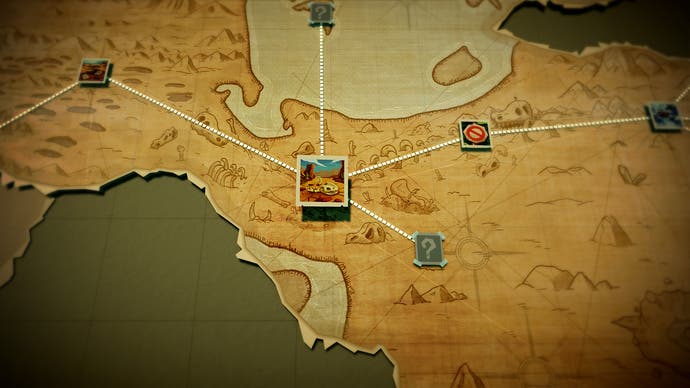
Really, it comes back to that depth of creativity from the studio. "It's very much an open process," says Huskins. "Everyone on the team is interested in chipping in ideas. You've got artists, designers, coders, producers, all chipping in.
"That's where you get that variety of different things coming from and some of the slightly left-field humour. Everyone's got a different sense of humour in the studio so we put that all in a melting pot."
He continues, discussing the interaction of systems: "We spend a lot of time chatting through this stuff and trying to apply a bit of Occam's razor and going 'do we need this thing? Is this just over-complicating the game if we add this in? Could we merge these two ideas together and this will be a more succinct system that gives us the depth we want?'" From there, the team is careful to gradually ease players in with tutorials, ensuring systems work from the start to hours later.
"Some of our players are extremely casual cosy players, but we also have some very hardcore management simulation players who really min-max it and play a certain style," adds Koehler. "We try ticking all the boxes for everyone, it's a lot of testing. And we don't always get it right, but we just iterate until it feels right."
Indeed, just as Two Point Campus iterated on Two Point Hospital, Two Point Museum looks to be doing the same. Fans of the studio's past work won't be disappointed.
Read this next
- Amazon reportedly working on animated anthology TV series featuring Spelunky and other video game worlds
- Let's Build a Zoo studio is making a game dev management sim where you design your own MMO
- Here's your PlayStation Plus Extra and Premium lineup for August

IMAGES
COMMENTS
Some suggestions and strategies are described below focusing on the three phases of a field trip: Before the visit; at the museum; and after the visit. 1. Before the Visit. •Make sure the purpose of the field trip is clear to the students and the chaperones to establish the appropriate atmosphere and your expectations for the day.
Many people feel instinctively that there is value to a museum field trip, but struggle to articulate exactly what it is. It's good for kids to get out of the classroom a couple of times a year. It's good for them to see knowledge at work in the real world. It's good for them to experience subjects like the arts that are frequently absent ...
A great resource for this kind of exploration is the Field Trip guide from Monument Lab. Remix the resources. Much of curators' work in a museum involves the sequencing of objects so that they tell a story. Exploring "how objects speak" is a compelling concept that can lend itself to deeper learning after a visit.
With field trips, public schools viewed themselves as the great equalizer in terms of access to our cultural heritage. Today, culturally enriching field trips are in decline. Museums across the country report a steep drop in school tours. For example, the Field Museum in Chicago at one time welcomed more than 300,000 students every year.
Plan a field trip that's full of discovery. Make the most of your day at the Field with resources designed for school groups pre-K through grade 12. Guide your students through an exhibition with engaging conversation starters and activities. Encourage their curiosity in cultures and the natural world as they examine specimens and artifacts on ...
Students love field trips and the museum environment helps them stay in line. Nonetheless, discuss behavior in advance, plan and tell them consequences for misbehavior. Student behavior is a reflection on you and the school, so make sure to follow through on consequences if needed.
Help us make our Exposition Park museum, and our L.A. community, a place where everyone can discover nature, science, and culture. 900 Exposition Blvd., Los Angeles, CA 90007. 213.763.DINO (3466) These free, printable field trip lesson plans will help your students connect classroom curriculum with their on-site museum experiences.
Impediments to Learning on a Museum/Field Trip. Your classroom provides structure, limits, and authority to focus student attention and behavior. All of these are seriously diminished or entirely dispensed with on a field trip. Therefore, in spite of your high expectations, the museum trip may end up having little or no educational impact on ...
An art museum field trip lesson plan to enhance learning for school, scout, homeschool, and camp field trips to art museums. Main Menu. Blog; Destinations. ... Many are online and you can download teacher and student material to enhance lesson plans before and after your field trip. KNOWLEDGE. Learn about art periods and the culture and history ...
School field trips provide an organized learning experience that is different from visiting a museum for entertainment purposes with parents or Scouts." * The term museum should be understood to include all informal education institutions and cultural resources maintaining a collection, and education staff and offering education programs to ...
Field Trips Field Trips. Request a Self-Guided Field Trip; Junior Science Academy; Partner Field Trips; Field Trip Steps. Step 1: Review Field Trip Logistics ; Step 2: Prepare For Your Field Trip; Step 3: Enjoy Your Visit; Step 4: Extend the Learning; STEM Programs; Homeschools; Higher Education Visits
Field trips enrich students' education by giving them opportunities to learn through new experiences in the real world. > CLASS ; COLLEGE ; TESTS ; VOCAB ; LIFE ; TECH ; Objectives of Field Trips. RALPH HEIBUTZKI 27 JUN 2018 CLASS. ... By touring an institution like the National World War I Museum, whose collection includes 75,000 artifacts ...
Whether it's a visit to a museum, a nature reserve, an historical site, or a local business, a well-planned field trip can bring learning to life in a way that textbooks simply cannot. ... Introduce the Field Trip Objectives: Start by clearly communicating the objectives of the field trip to the students. Explain why the chosen location was ...
Many science museums offer interactive experiences for youth groups such as labs and simulated space missions. Find a science museum with offerings that align with your curriculum goals for a field trip that'll be worth while. Put on those lab coats and goggles! Students step into the shoes of scientists.
The trips will take place on Jan. 24, Jan. 31, Feb. 8, and Feb. 14, with Feb. 22 as a backup day. To express interest in your school or classroom visiting the museum, please fill out the appropriate form. Request a K-5 field trip. Request a 6-12 field trip
Museum Field Trip Options. Art and Architecture of the National Archives. Grades: K-2, 3-5, 6-8, or 9-12 90 minutes. Designed by American architect John Russell Pope in the 1930s, the National Archives Building and especially its half-domed Rotunda offer an awe-inspiring setting in which to visit the U.S. founding documents. This program asks ...
With field trips, public schools viewed themselves as the great equalizer in terms of access to our cultural heritage. Today, culturally enriching field trips are in decline. Museums across the country report a steep drop in school tours. For example, the Field Museum in Chicago at one time welcomed more than 300,000 students every year.
The first children's museum in the world was the Brooklyn Children's Museum, founded in 1899. Hundreds of children's museums have opened in the United States since then. As of 2007, the Association of Children's Museums estimated that there were approximately 80 children's museums in development alone. Children's museums are unique ...
Summer Field Trips. Junior Science Academy. Stay Curious, Utah! Before booking a field trip: Submitting a request does not guarantee a reservation. Requests should be submitted at least 10 business days prior to your desired visit date. Watch for your confirmation email or contact from field trip staff.
The field trip is designed for learners ages 5-8 and includes hands-on drumming or musical story time in addition to gallery exploration with a museum guide. "Our children connected with their ancestral heritage," says a kindergarten and 1 st grade teacher from the Pendergast Elementary School District whose class took a Celebrations ...
The Museum is closed through early 2025 for renovations. Find out what is currently on view and plan your visit to the Museum. The Florida Holocaust Museum, a service provider contracted by the Florida Department of Education, invites you to use our dynamic lessons and curriculums about the Holocaust, genocide, and character education.
NASA's Chandra X-Ray Observatory was deployed by space shuttle Columbia on July 23, 1999. An Astronomically Important Shuttle Mission. Twenty-five years ago this summer, space shuttle Columbia lifted off and made history. STS-93 was the first shuttle mission commanded by a woman (Eileen Collins), and it carried some very special cargo: the Chandra X-ray Observatory.
Aug 12, 2024 - Looking to get inspired on your trip to St. Petersburg? Immerse yourself into world-class art, exciting history, and mind-bending science. Check out the best museums in St. Petersburg to visit in 2024. Book effortlessly online with Tripadvisor!
The Dali Museum. 8,548 reviews. #19 of 194 things to do in St. Petersburg. Speciality MuseumsArt Museums. Closed now. 10:00 AM - 5:30 PM. Write a review. About. An unparalleled collection of Salvador Dali artworks, spanning his life and career, featuring works in many media.
Charlotte Pride is just days away. The Levine Museum of the New South is ready with a museum exhibit, and will also be present at the festival. Learn more about the museum's Pride involvement in the video player above. About Charlotte Pride. The Charlotte Pride festival will run from noon-11 p.m. on Saturday, and from noon-6 p.m. on Sunday.
W ho doesn't remember the most fun and exciting part of school growing up: the field trips. It didn't matter if you were going to see the inner workings of a sewage plant or a museum, you knew ...
-Grade 3: Our Urban Habitat (field trip to Natural History Museum) -Grade 4: Rock On! (field trip to Natural History Museum) -Grade 5: Where Is your Water Footprint (eco-audit of water ... Educator Objective: All educators are prepared and equipped with sustained professional development, tools, and resources to provide ...
Grand Menshikov Palace in Oranienbaum dominates the surrounding grounds. The palace was altered again in 1762 by Antonio Rinaldi, who added a granite staircase and semi-circular balcony to the northern terraces and redecorated many of the interiors. After serving as a Naval Cadet College from the end of the 18 th century, the palace was used as ...
It's time for a field trip to the most absurd museum on Earth. Oliver Brandt | 0 Minutes Ago. Sega. After the wildly successful (and wildly fun) Two Point Hospital and its follow-up Two Point Campus, the developer of the Theme Hospital spiritual successors has finally revealed the third game in its wacky series. It's called Two Point Museum ...
One expert came back from a trip with an illness and trod muddy footprints across the pristine floors of my museum. Two Point hinted even more tragic events could occur. Experts may even perish ...